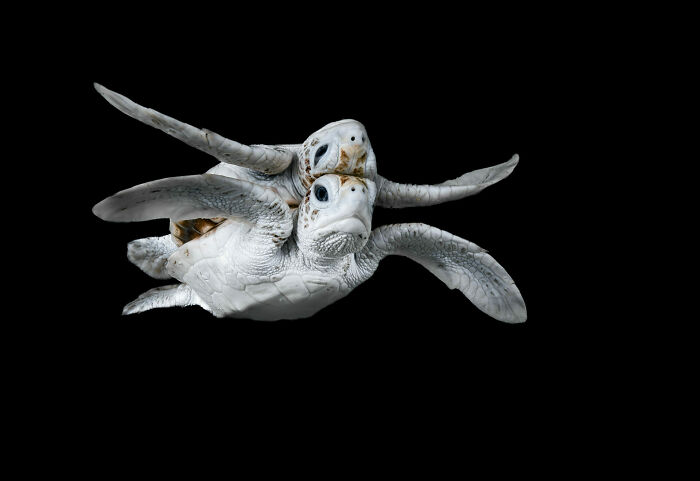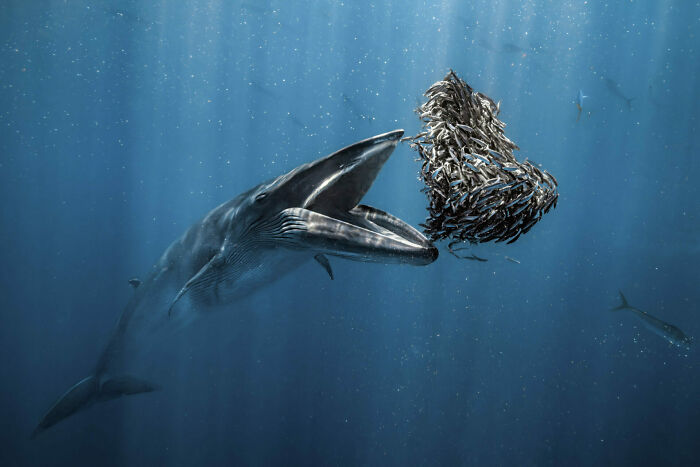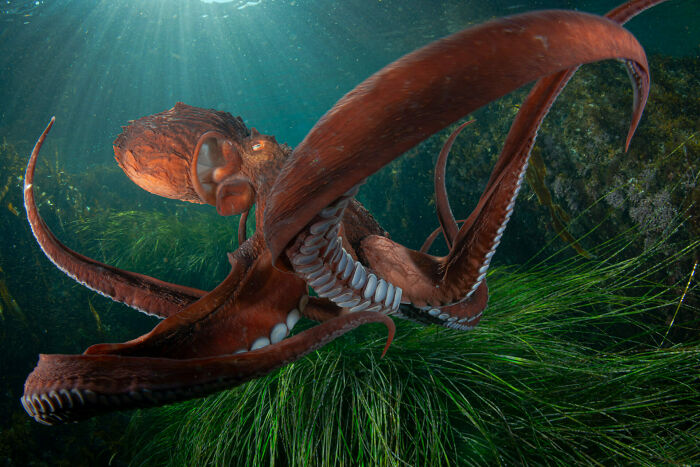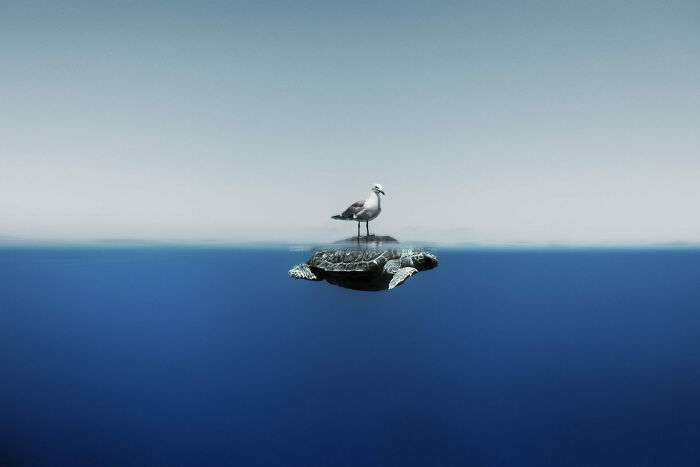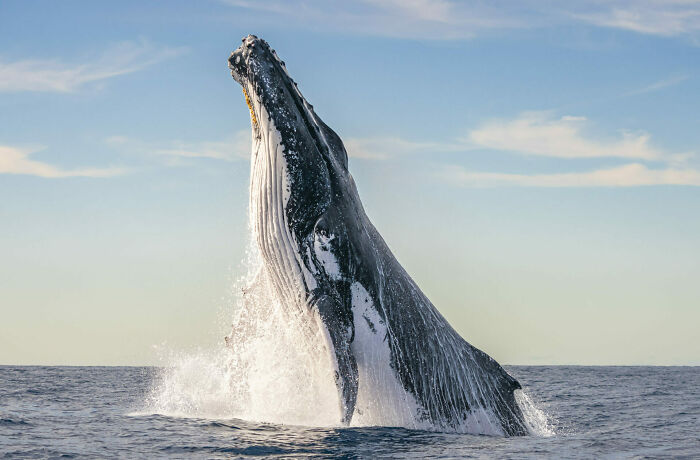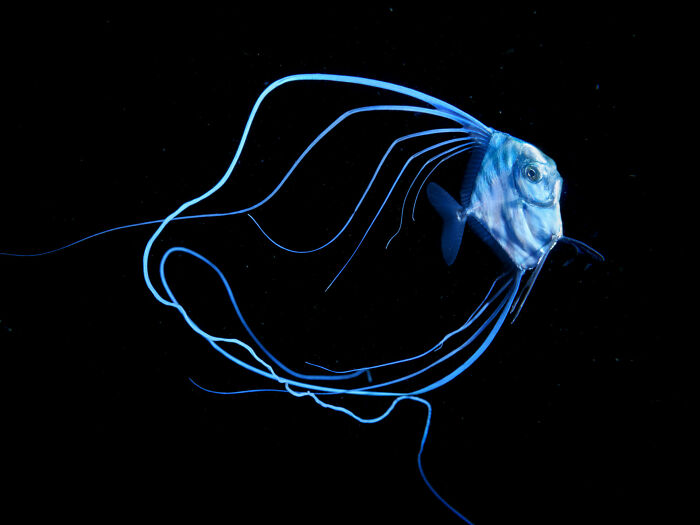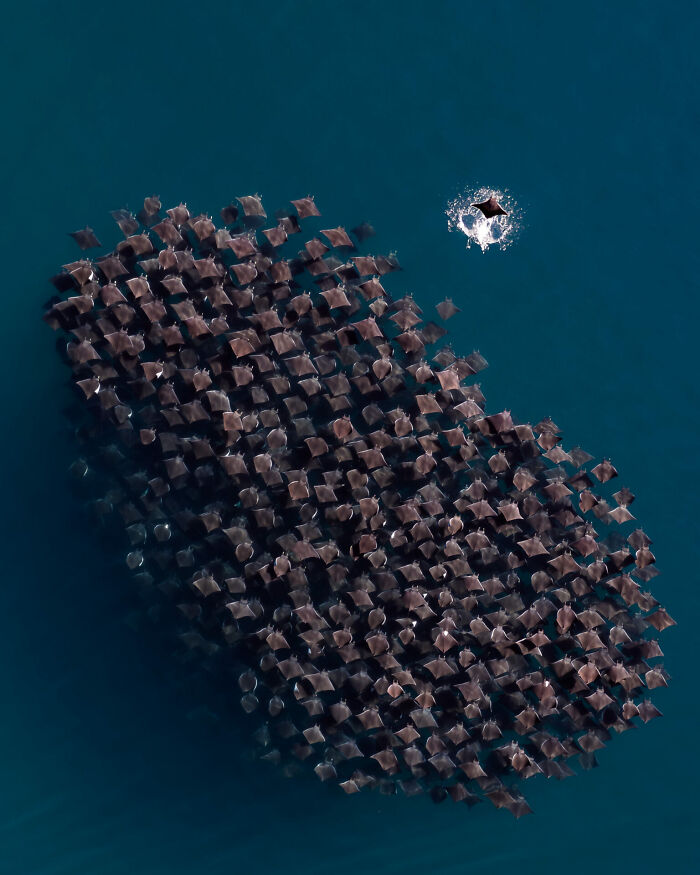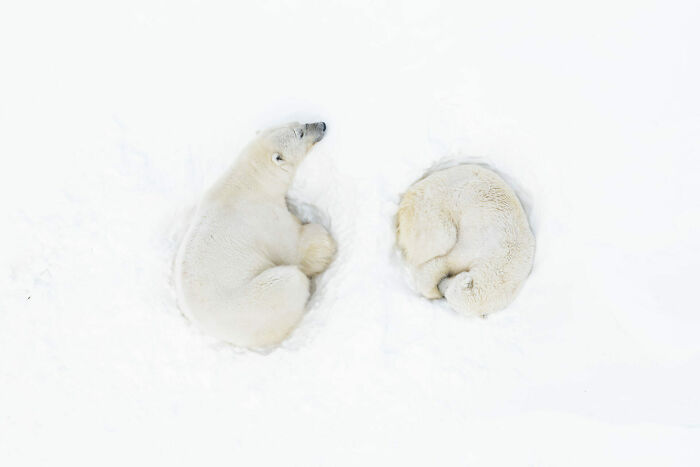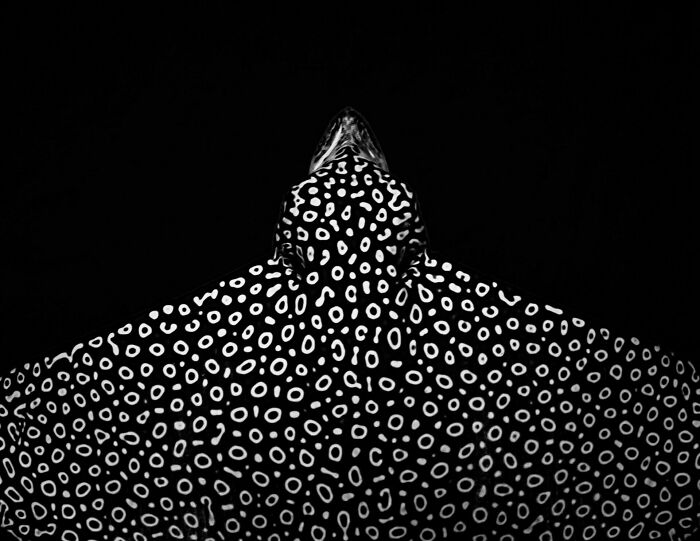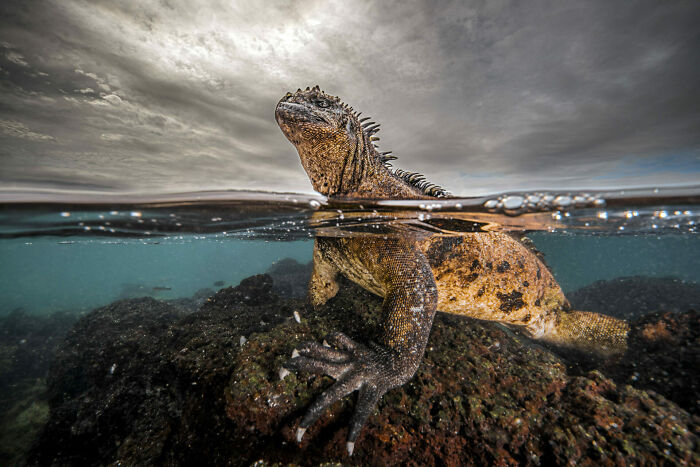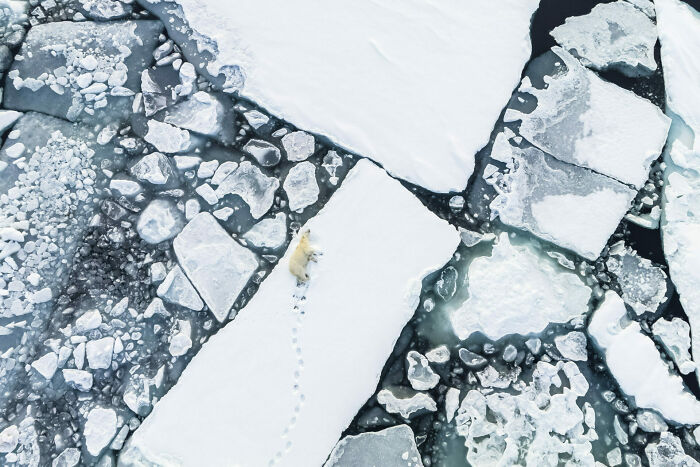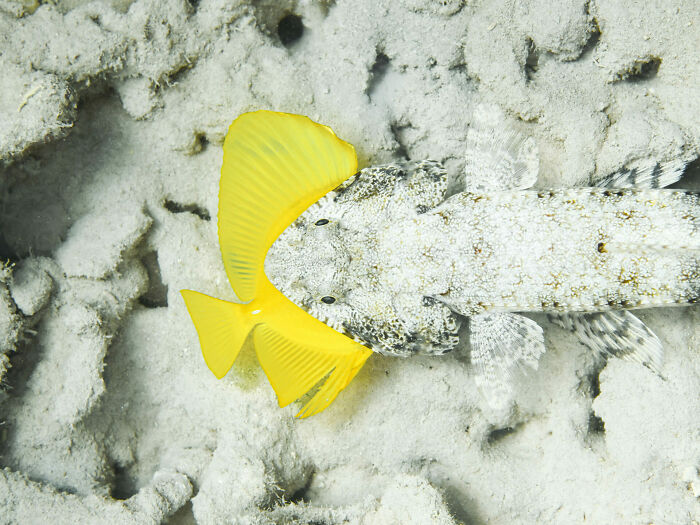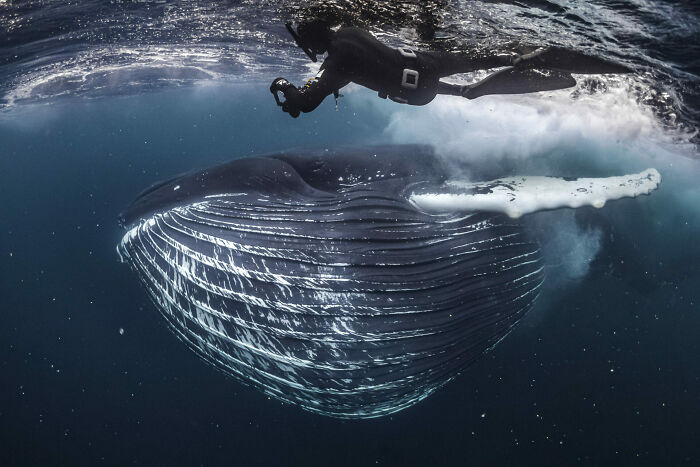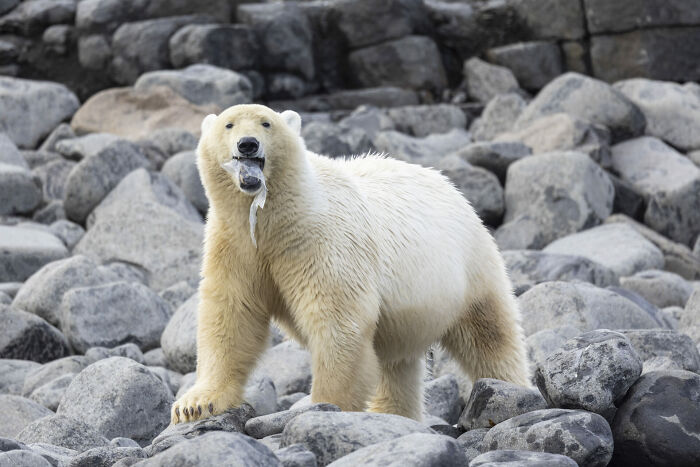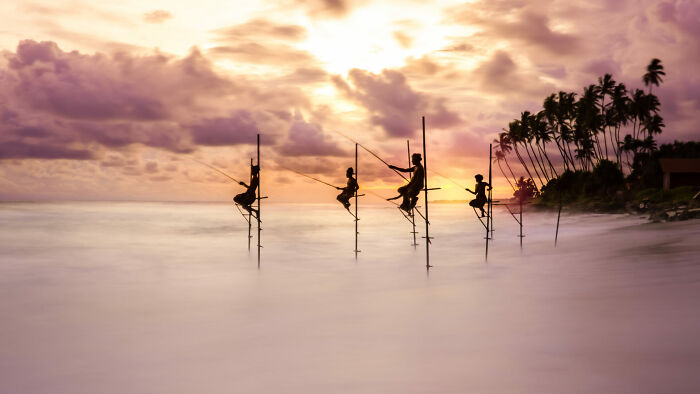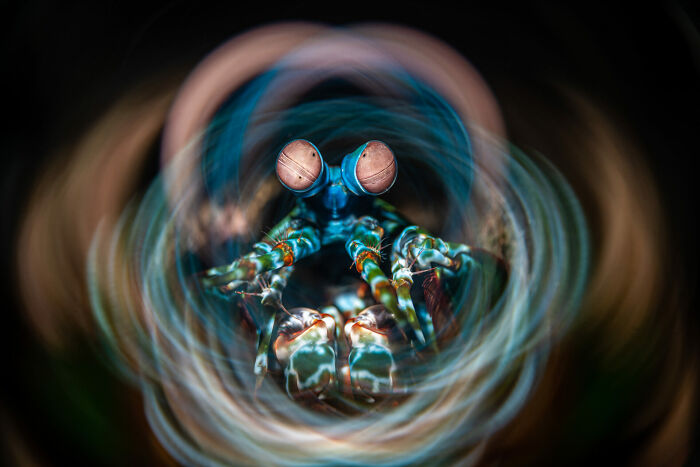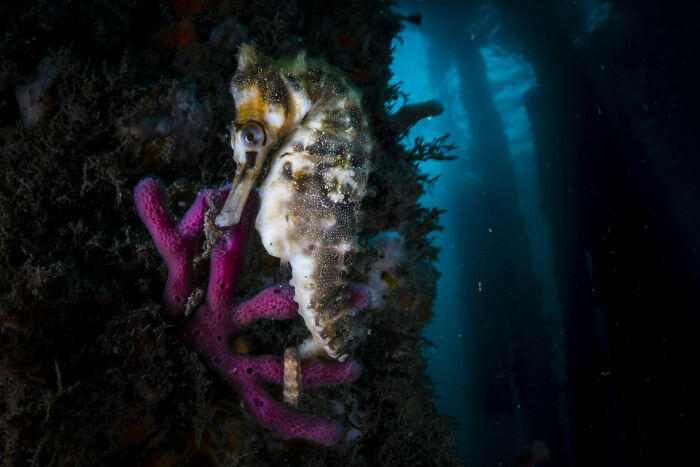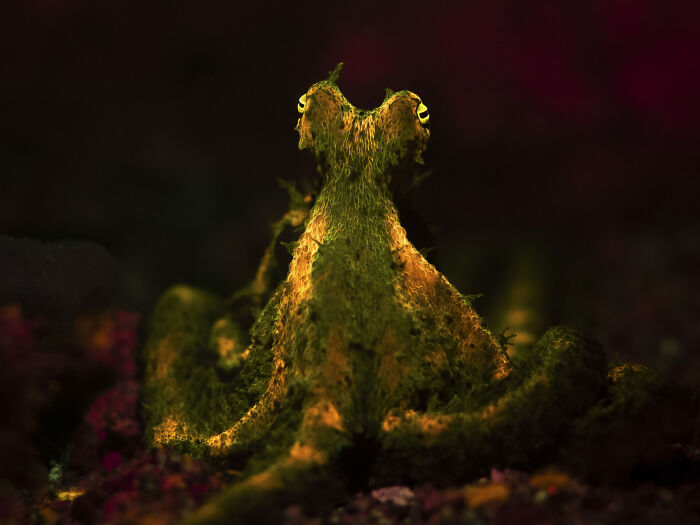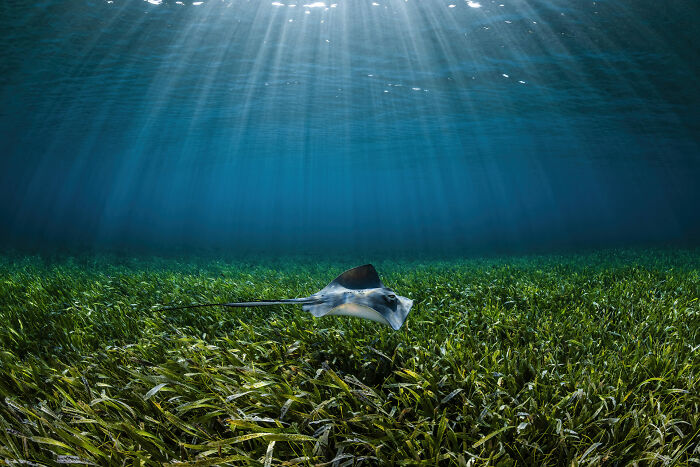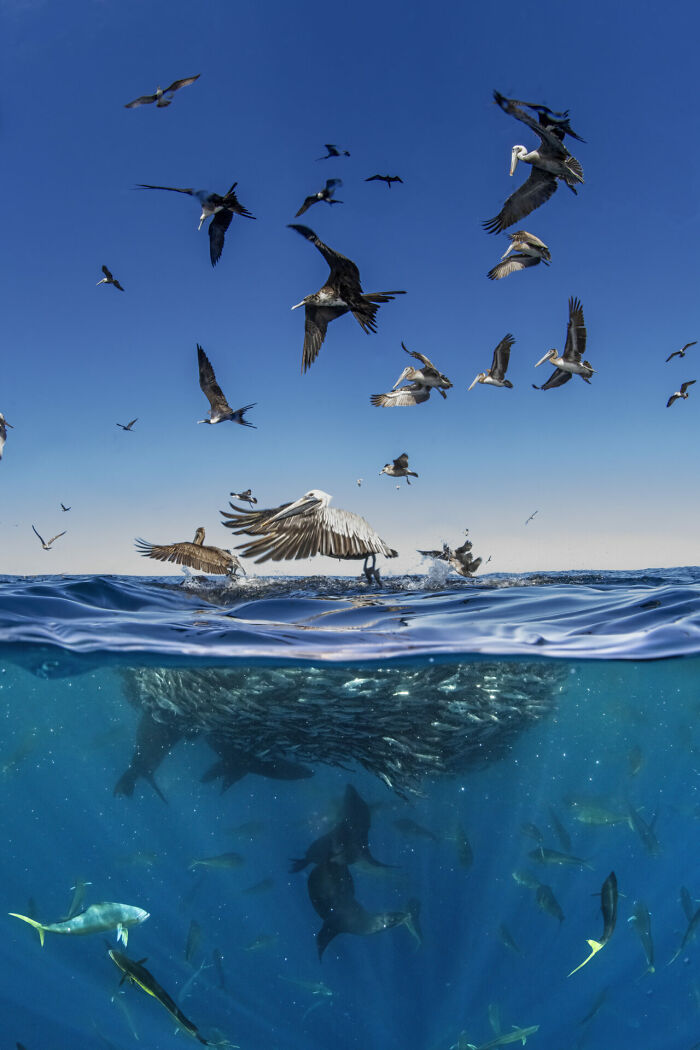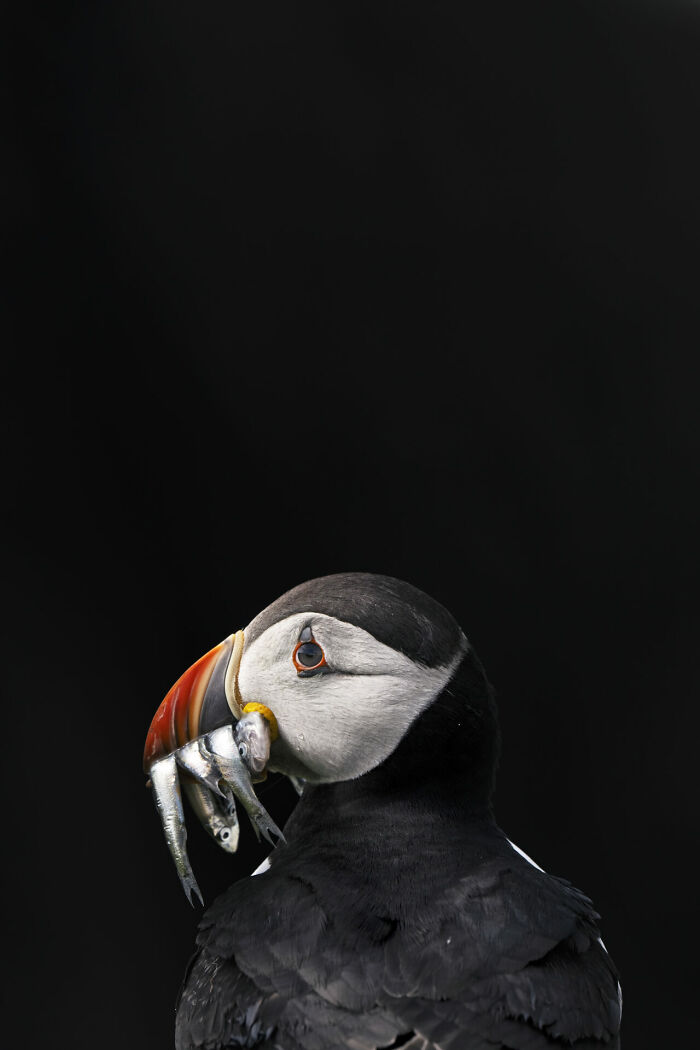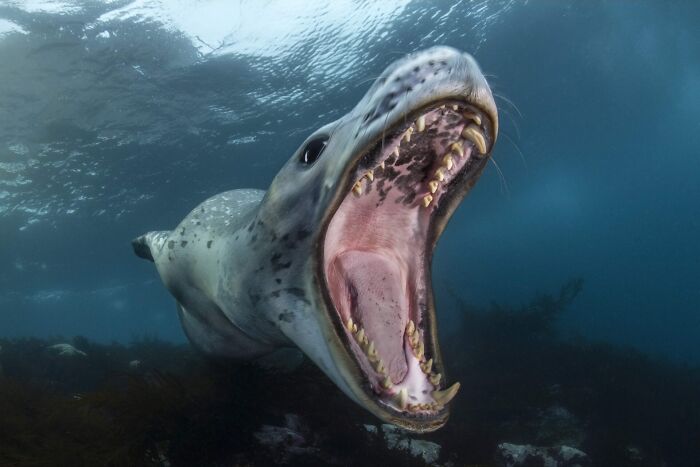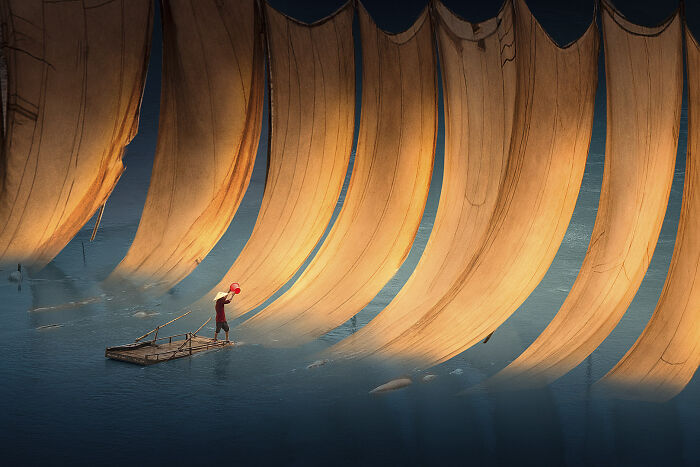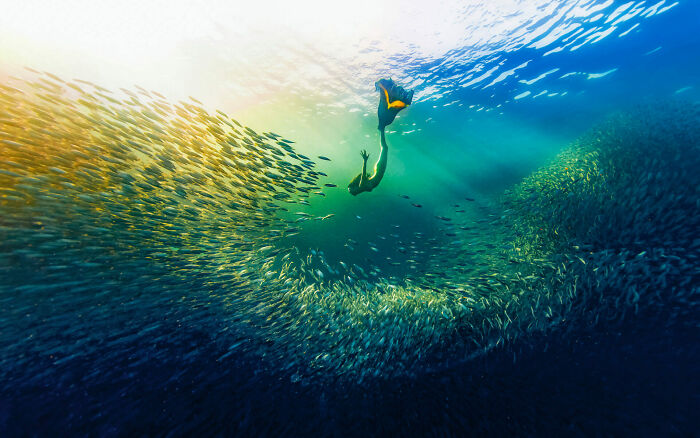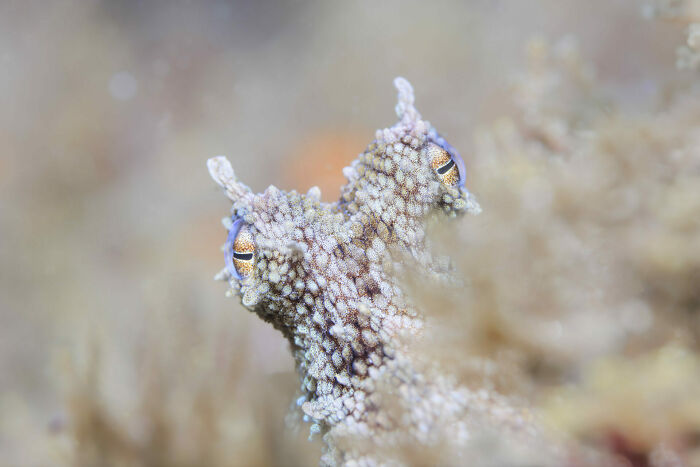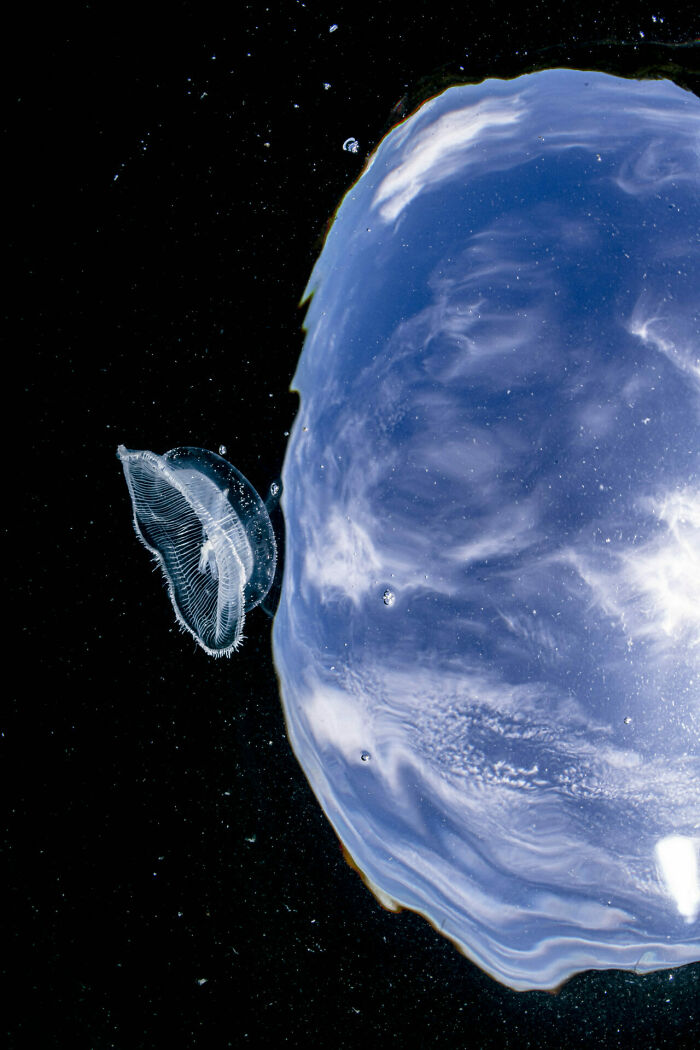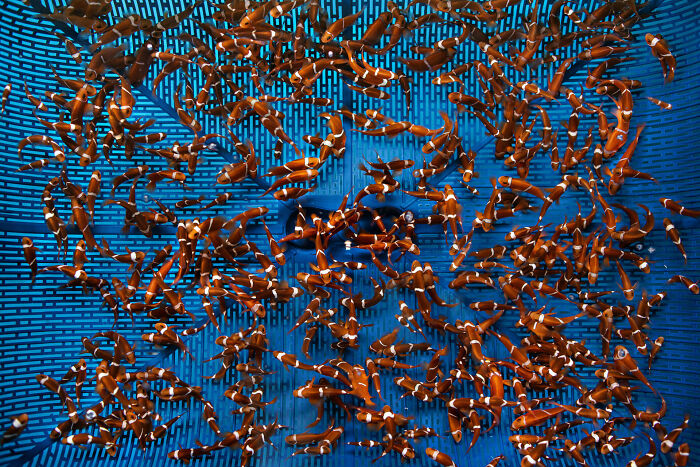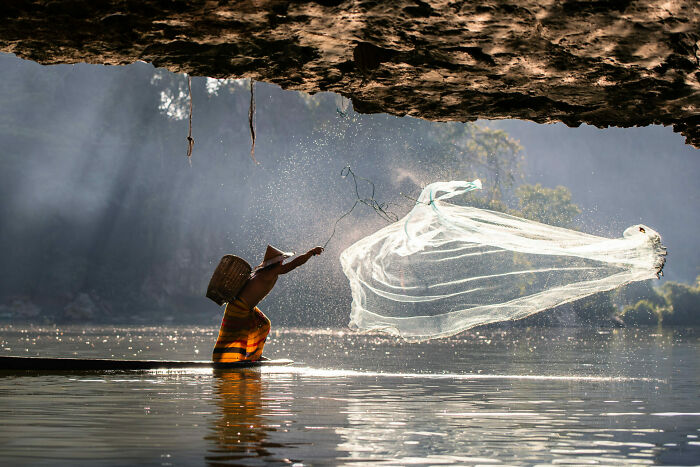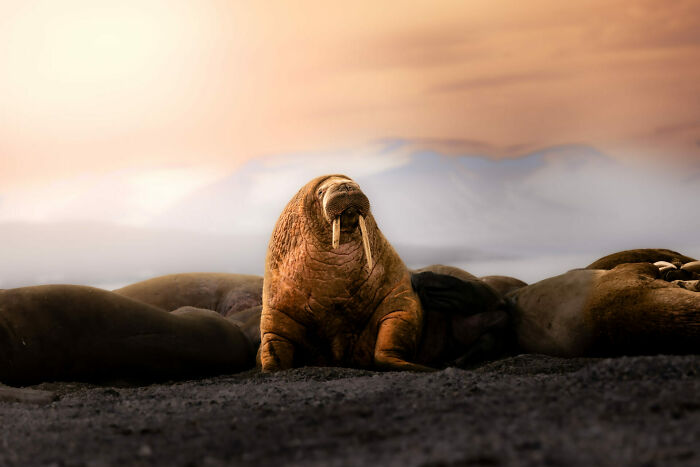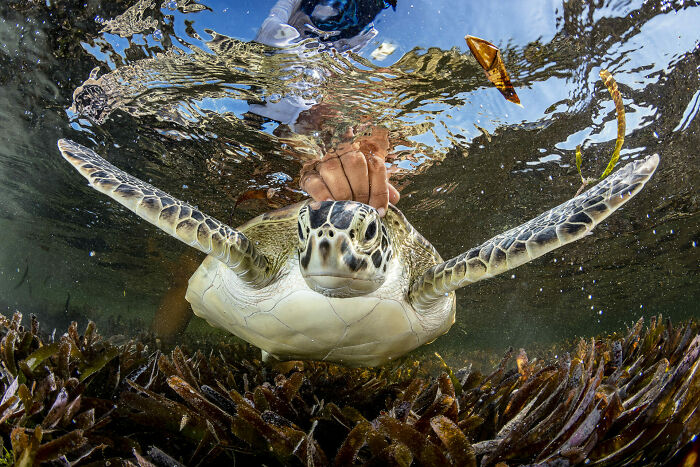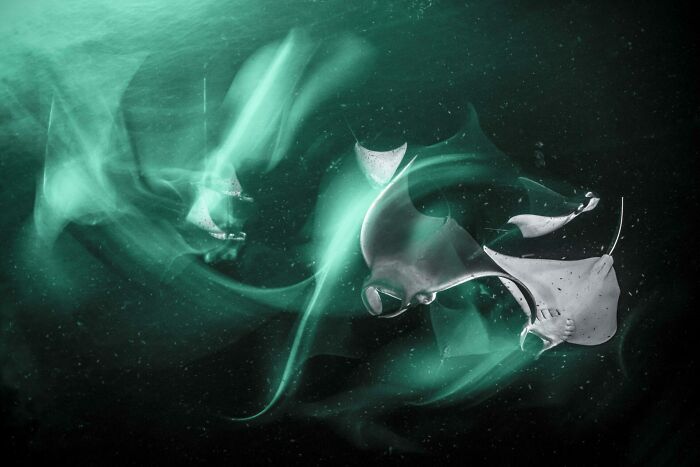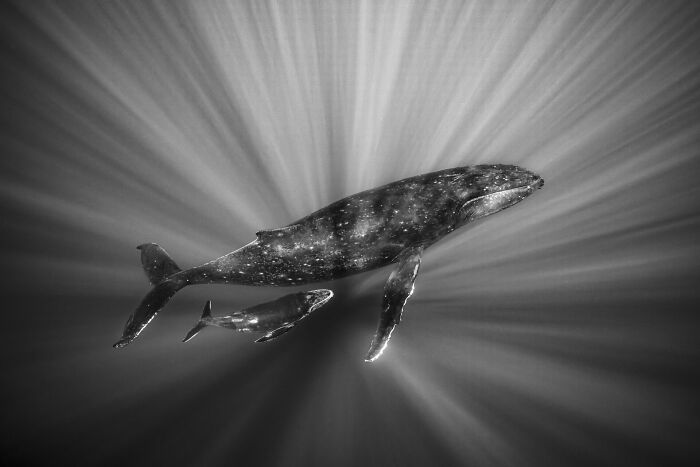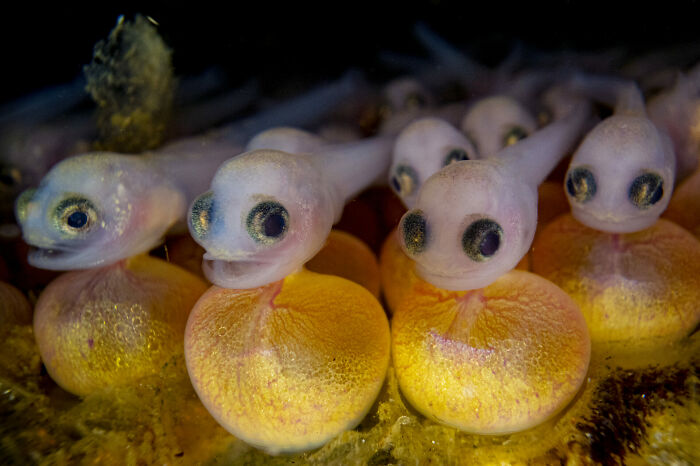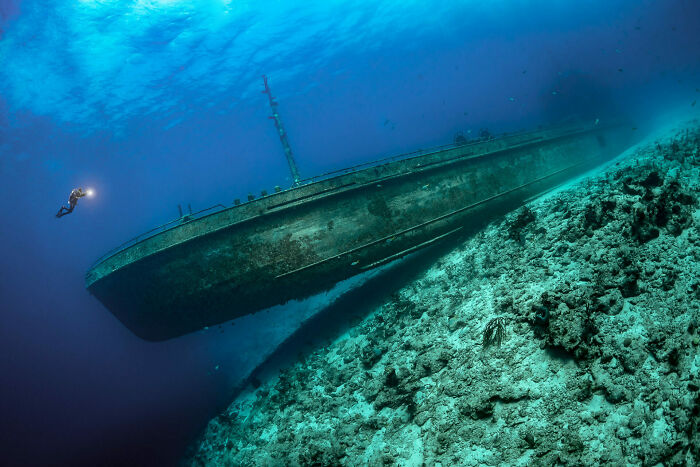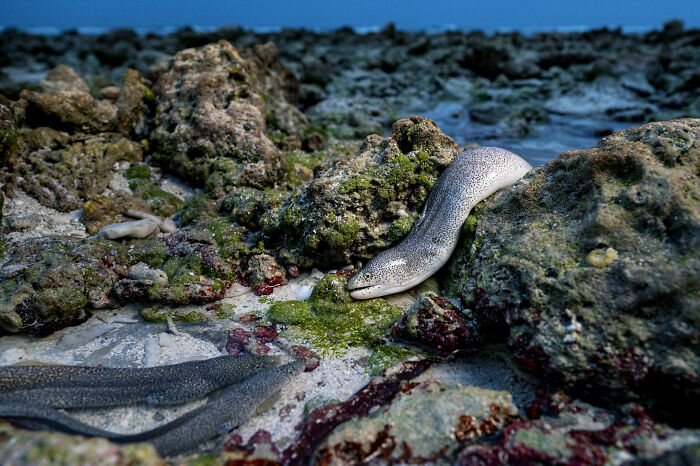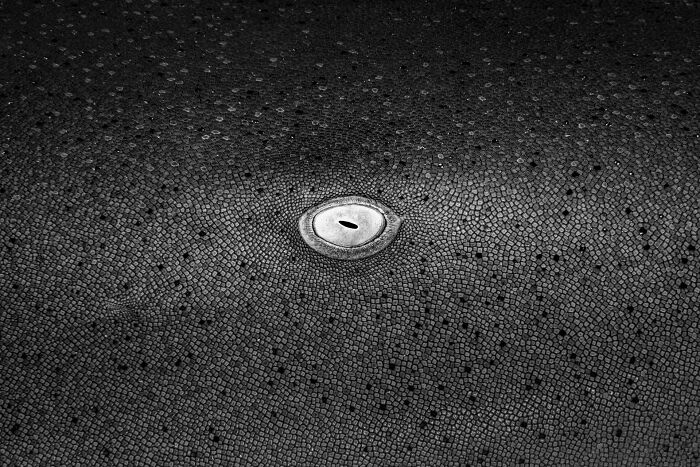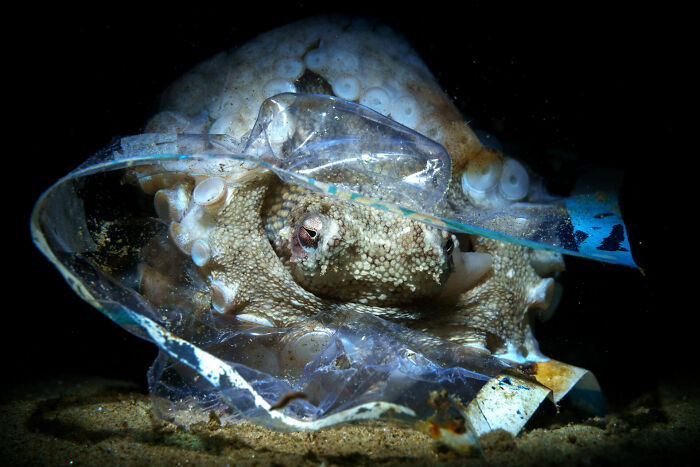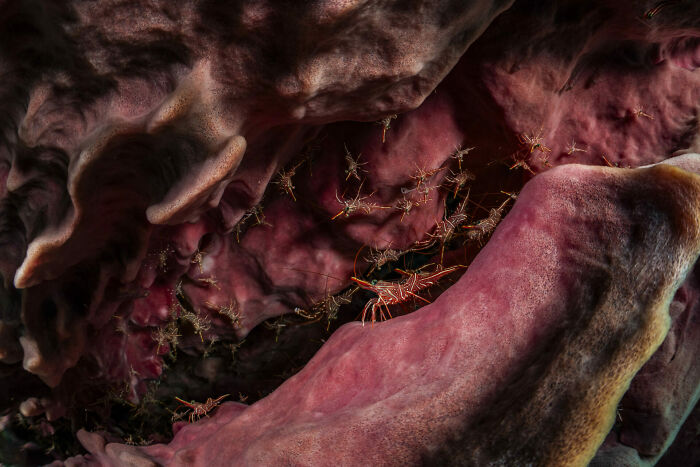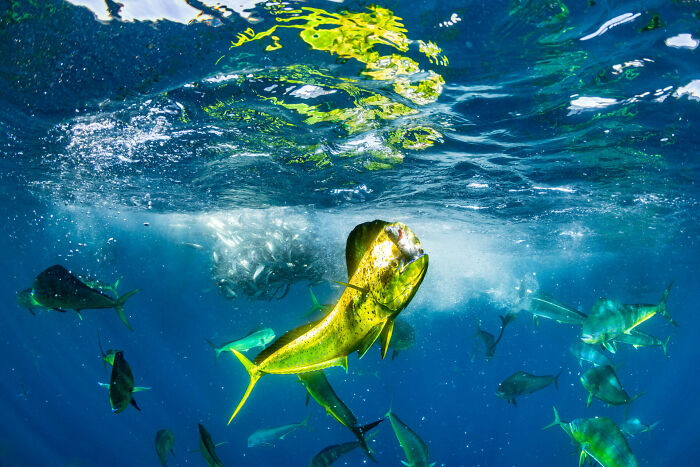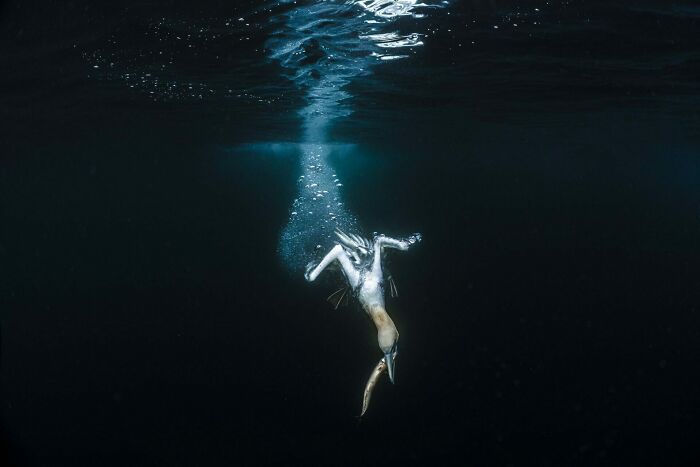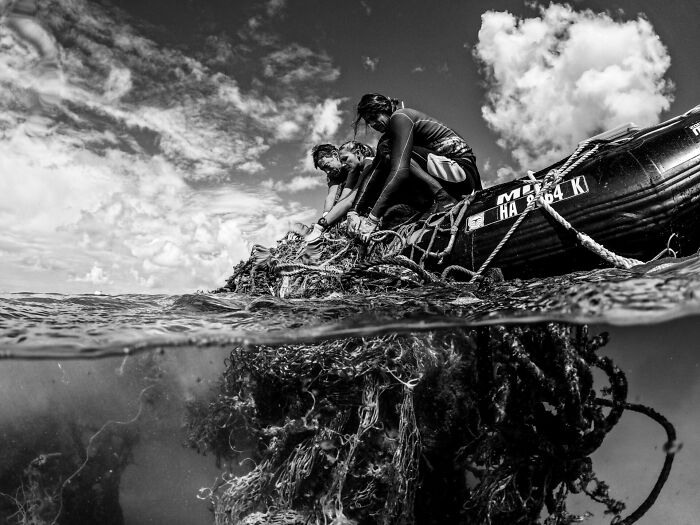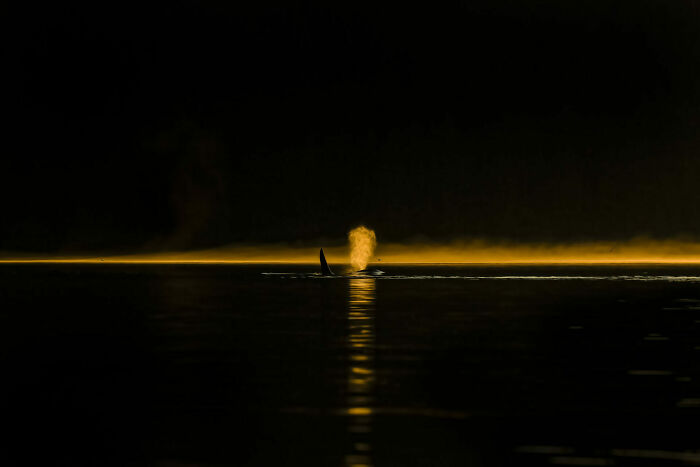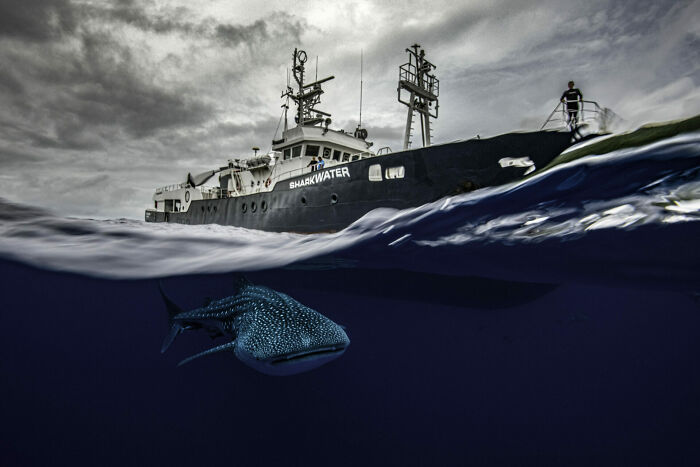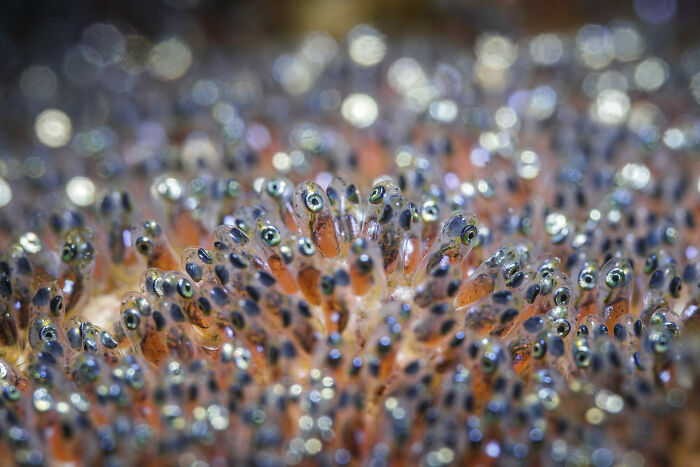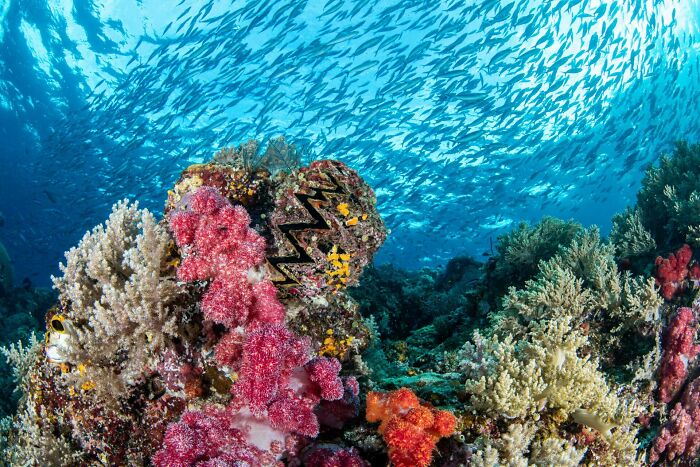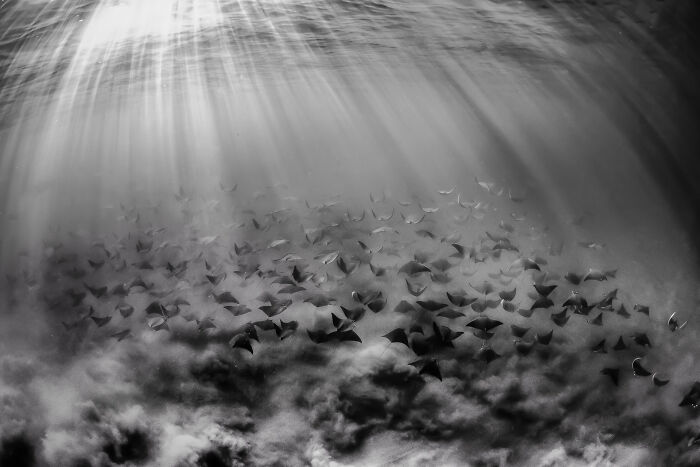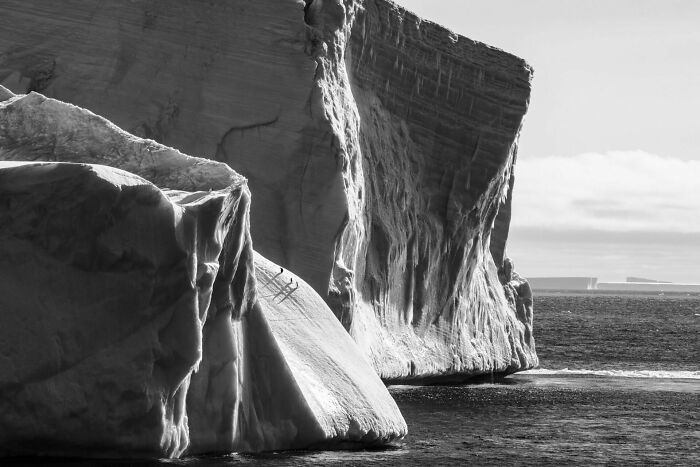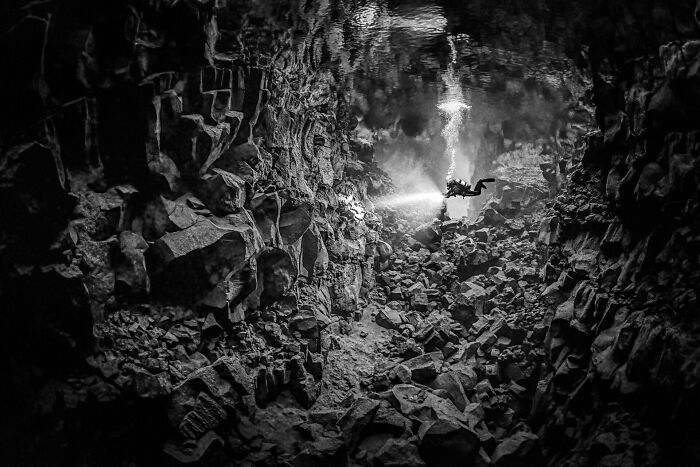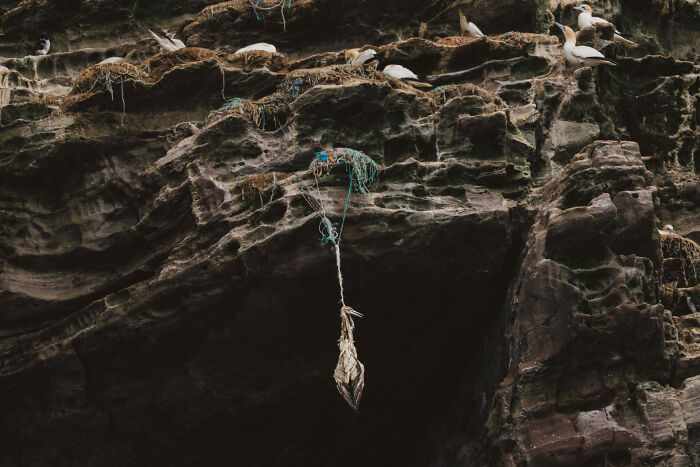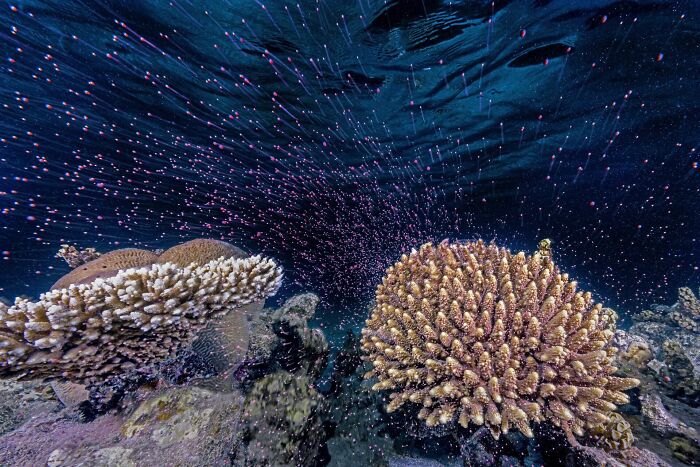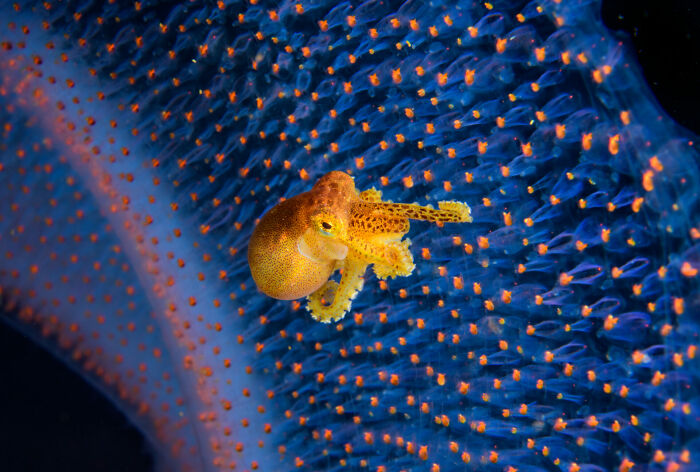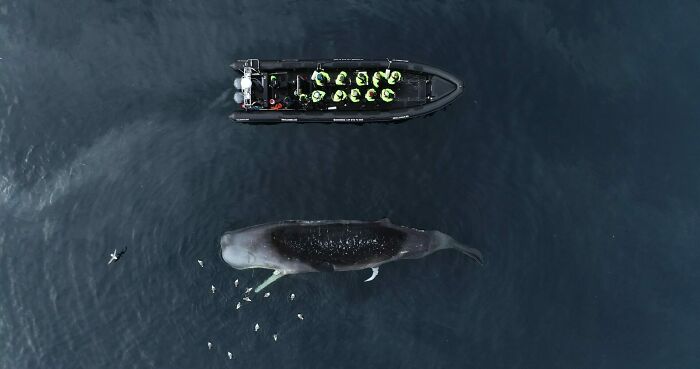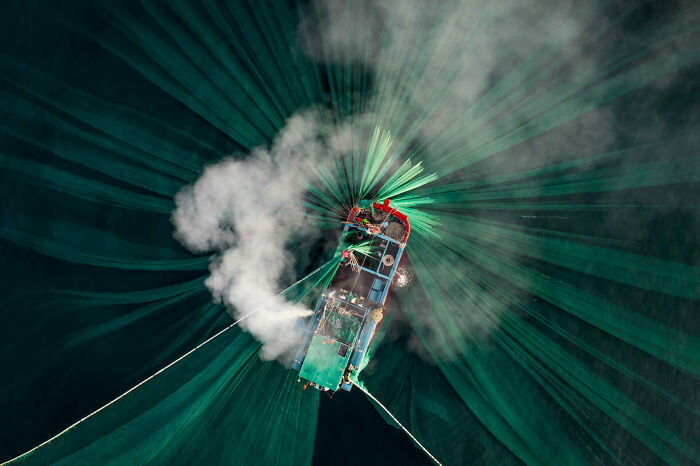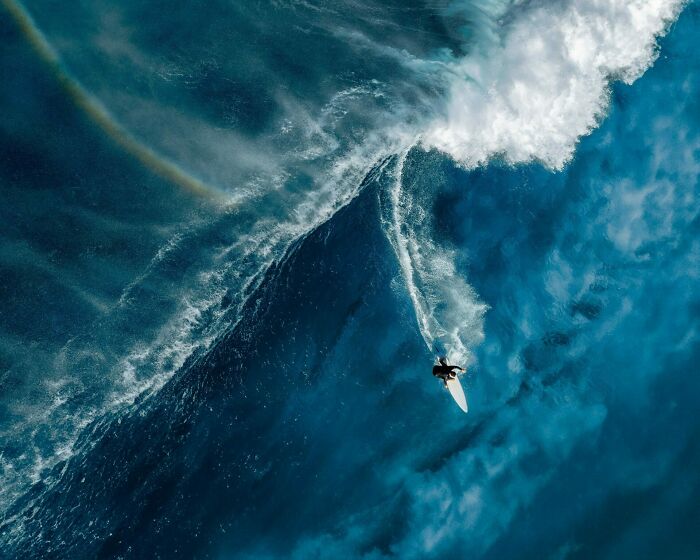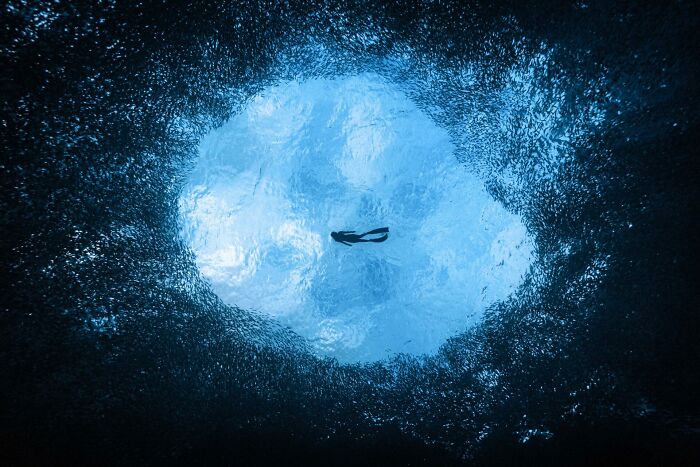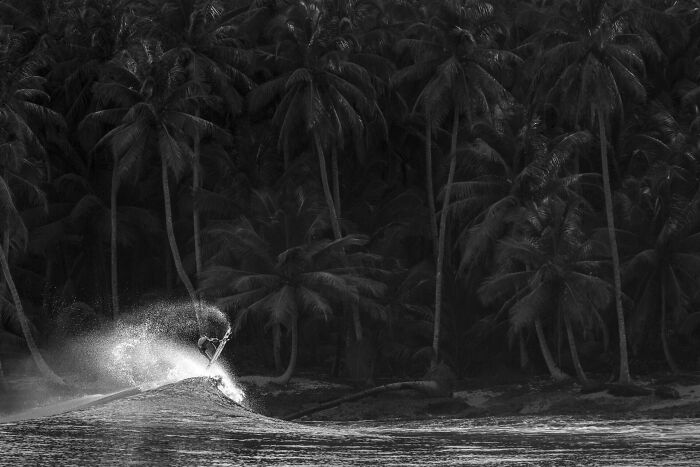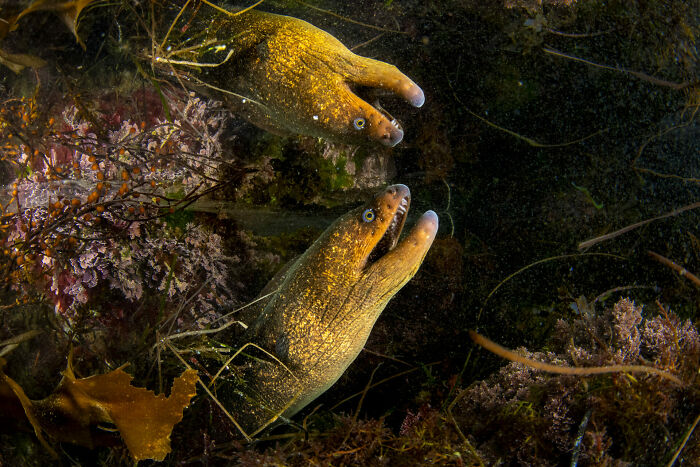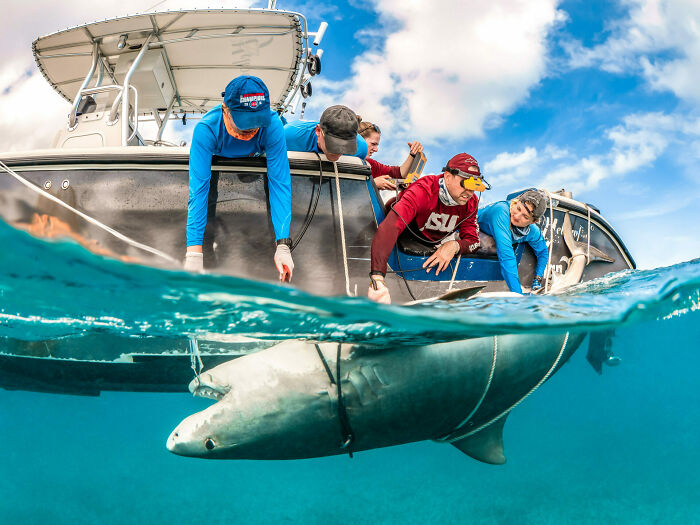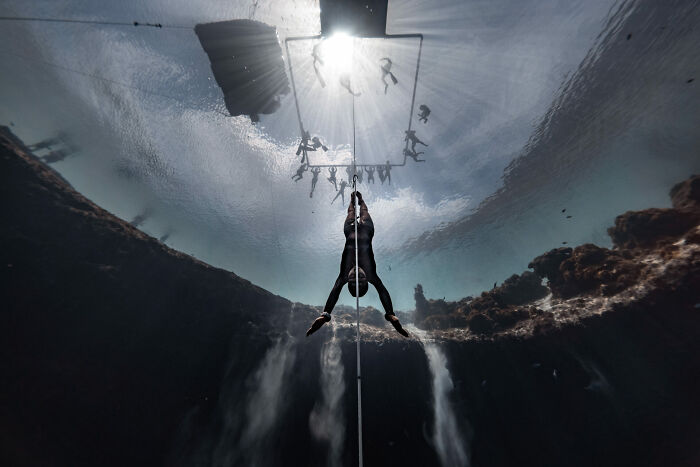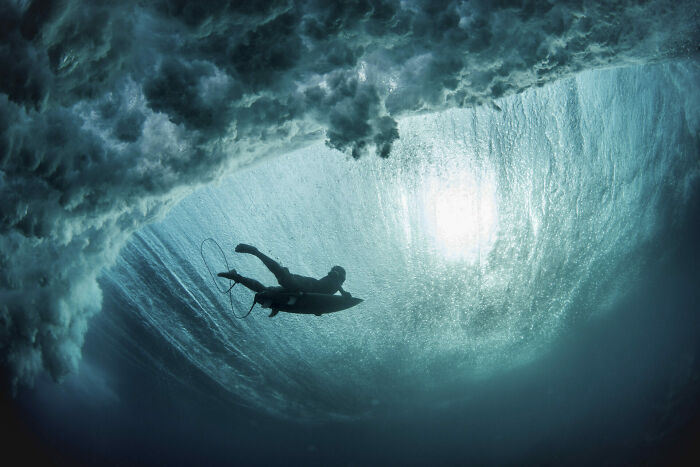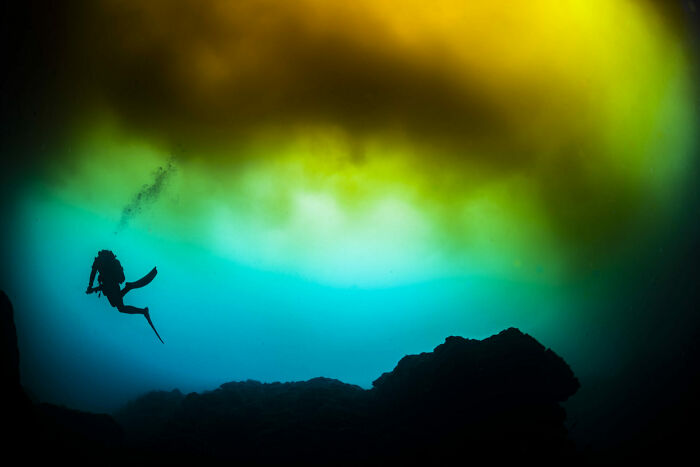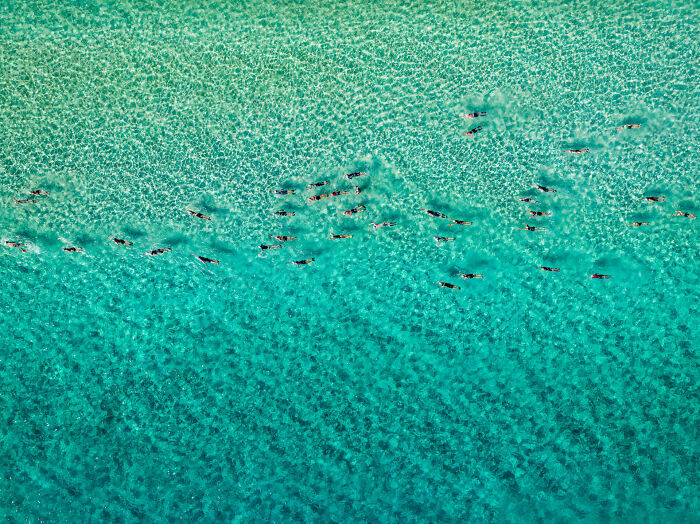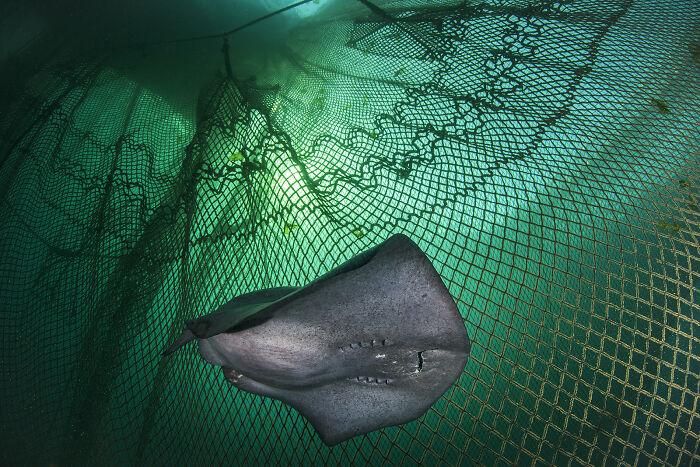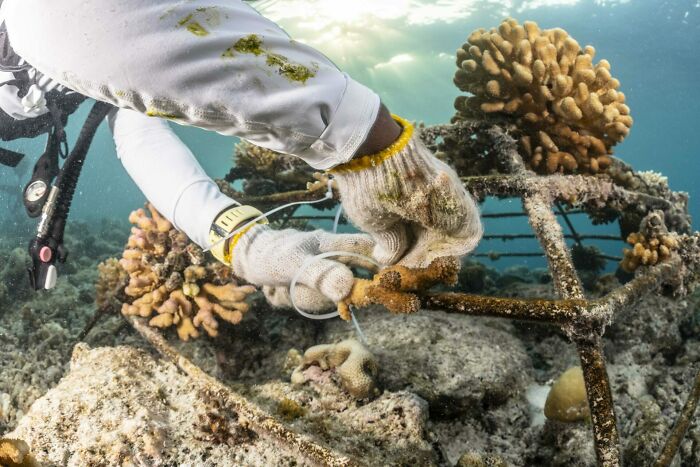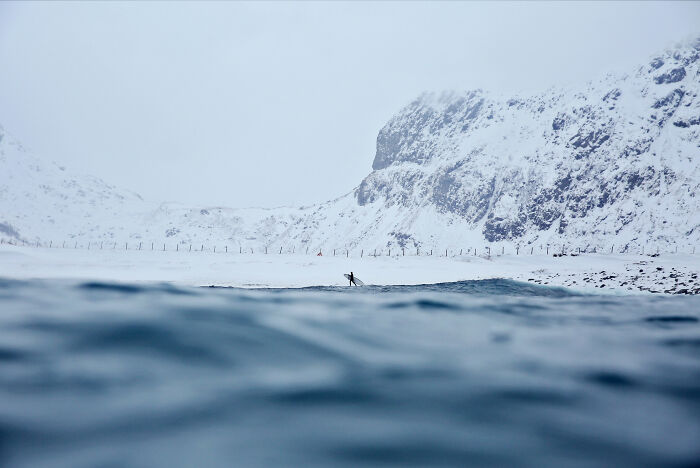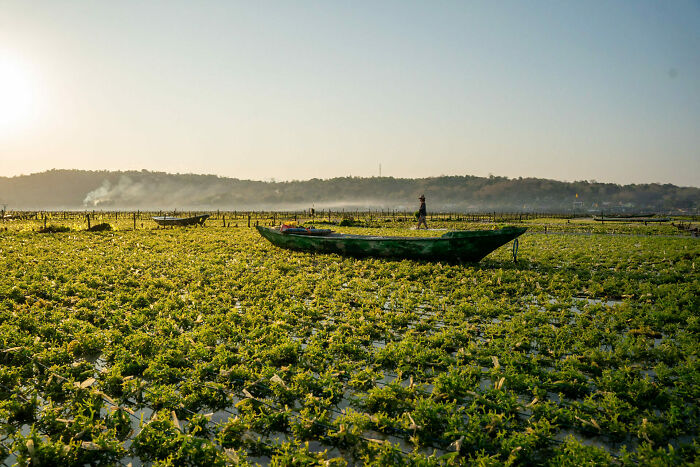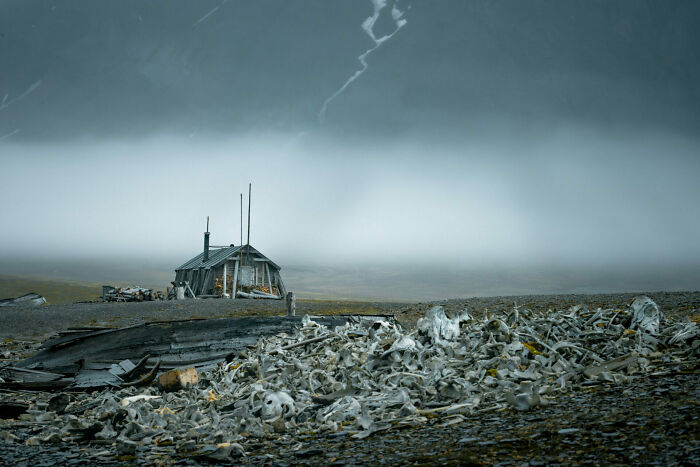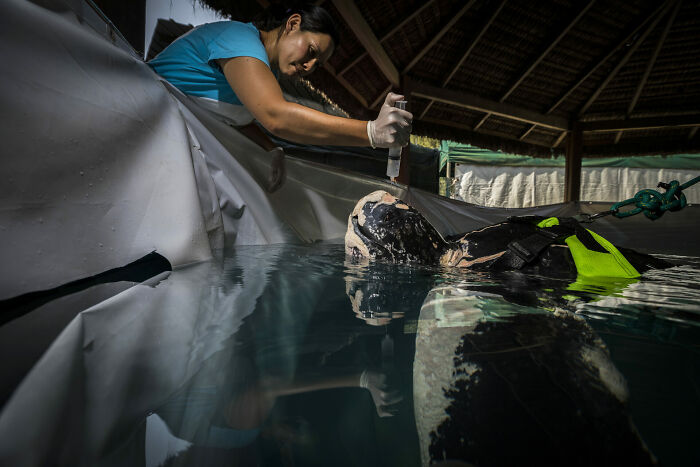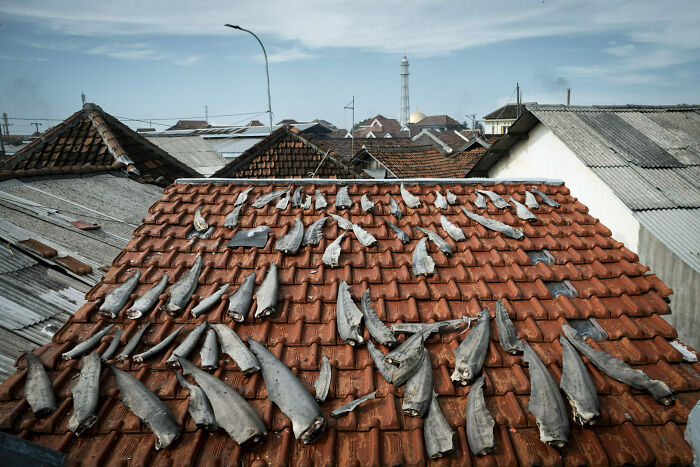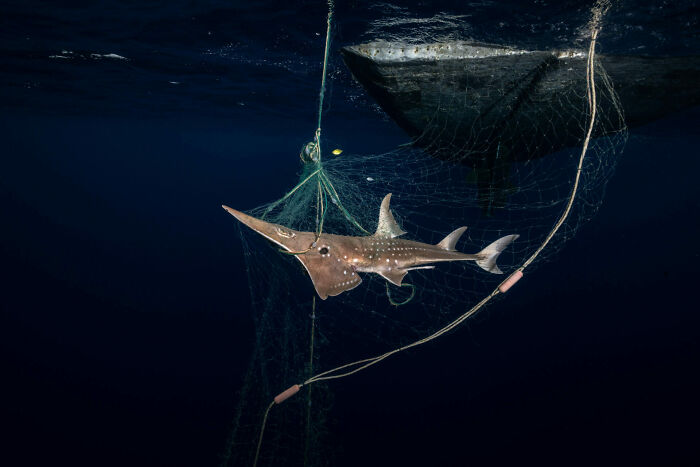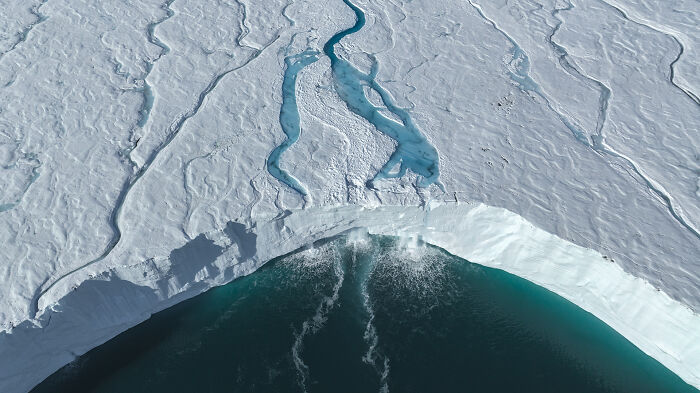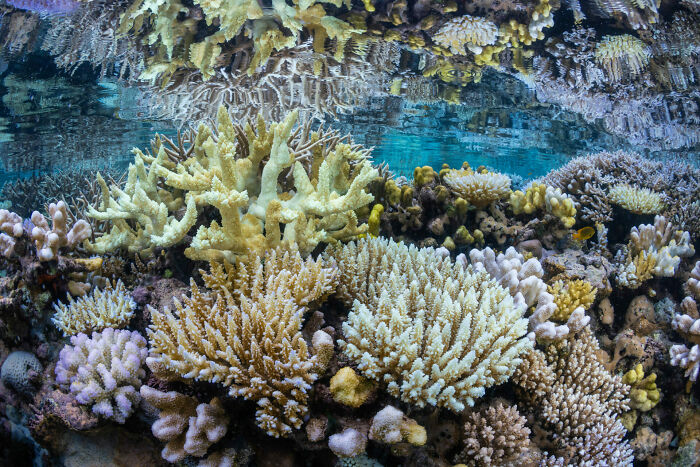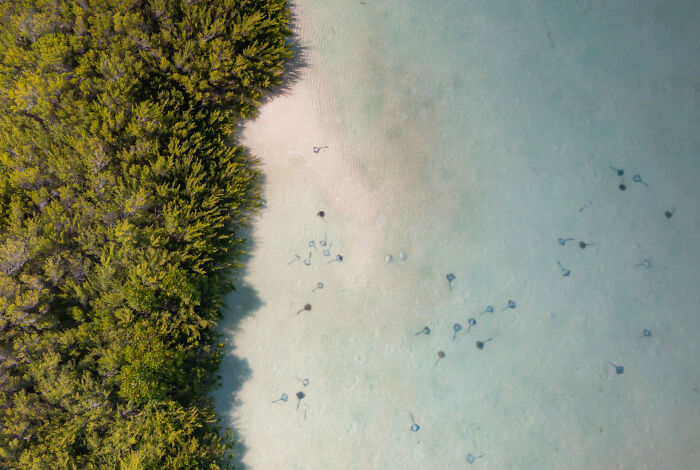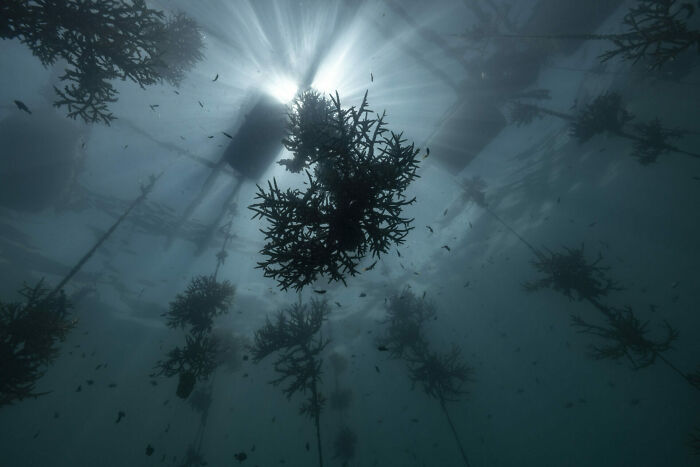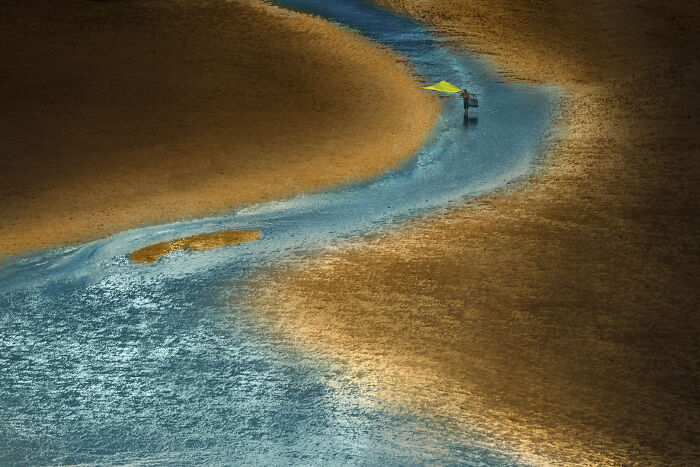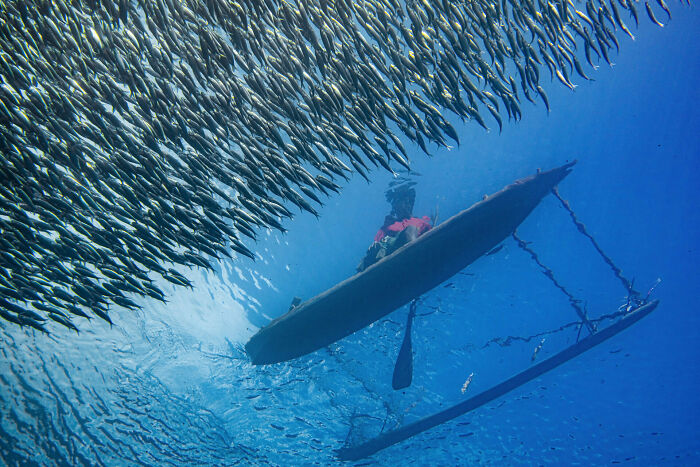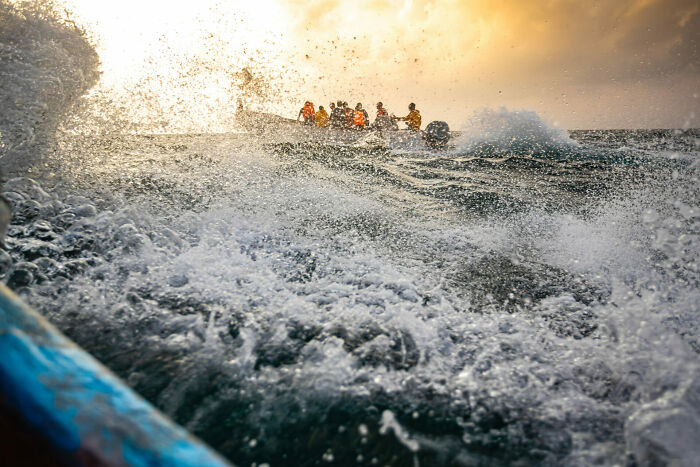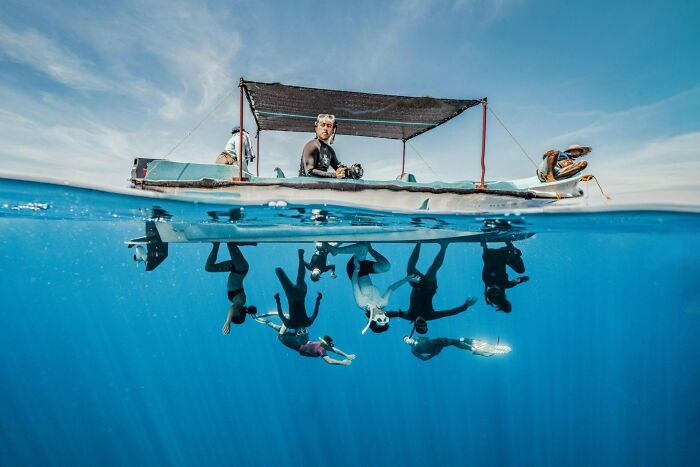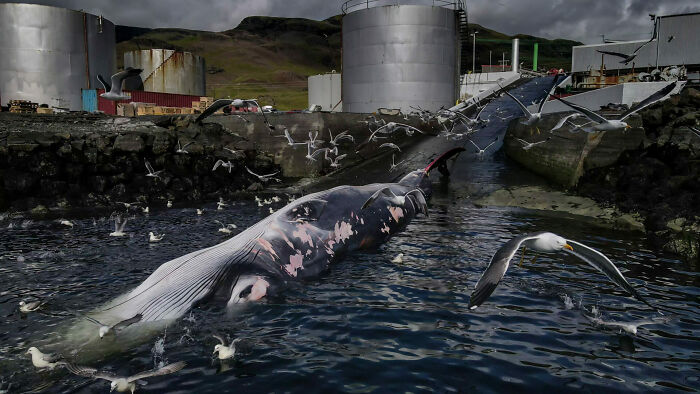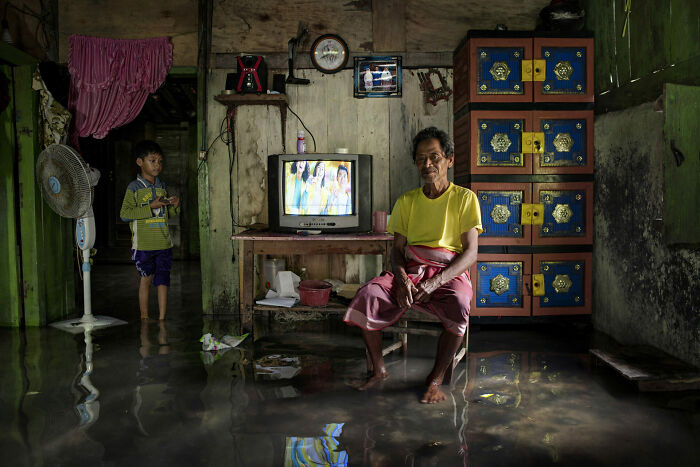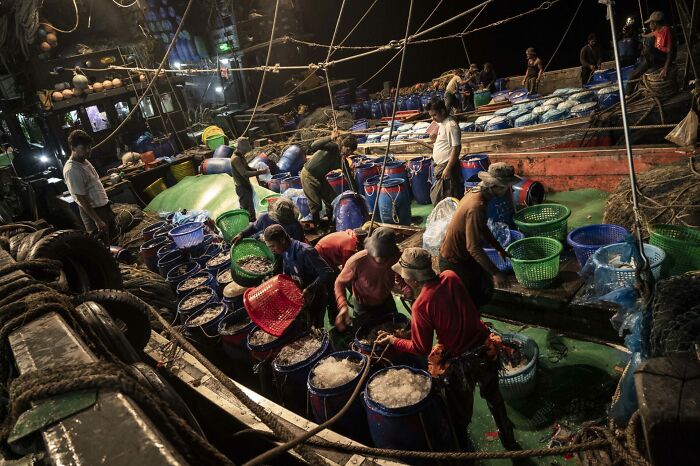The Ocean Photographer of the Year Awards 2024 has once again brought together the most breathtaking images from our oceans. Hosted by Oceanographic Magazine, the competition celebrates photographers who capture powerful moments in nature, from huge sea creatures to the peaceful life below the surface.
This year’s winners and finalists share captivating views of our oceans, reminding us how big and fragile they are. Each photo tells a story, helping us explore and understand the underwater world while also showing why it’s important to protect it for the future.
More info: oceanographicmagazine.com | Instagram | x.com | Facebook | Instagram
Conflict Islands, Papua New Guinea
In Papua New Guinea's Conflict Islands, conservation efforts have transformed former poachers into protectors, boosting turtle hatchling numbers. “Amid this success, a rare leucistic green sea turtle was found amongst the nests,” says Wilton. “Using the surface of the calm water I captured the striking reflection of the hatchling as it surfaced for air. The discovery is a testament to the successful turnaround in conservation efforts and the beauty of these endangered creatures.”
Oceanographic Magazine Report
The first-place winner, Rafael Fernández Caballero from Mexico, captured an unforgettable moment in Baja California Sur—a Bryde’s whale about to eat a school of sardines. Second place went to Jade Hoksbergen, who took an exciting photo of a northern gannet diving into the water off the Shetland Islands. In third place, Thien Nguyen captured a striking aerial photo off the coast of Hon Yen, Vietnam. These photos offer a glimpse into the vibrant and delicate world of our oceans, inspiring us to appreciate and protect their wonders.
Baja California Sur, Mexico
A Bryde’s whale takes a bite. “A feeding frenzy is the biggest show on earth for me. The smallest animals on earth, plankton, attract bait balls of sardines and, in turn, giant whales show up,” says Fernández Caballero. “I was lucky to witness this show off Baja California Sur at the end of 2023. Due to El Niño and warmer temperatures, different species joined the party and I witnessed huge numbers of beautifully colored dorados and large groups of sea lions that were attracted by the bait balls. The highlight was this whale coming out of nowhere with its mouth wide open.”
Oceanographic Magazine Report
Russia
A giant Pacific octopus in the shallows. “In late autumn, when the water temperature drops sharply to 5 degrees Celsius, giant Pacific octopuses rush to shallow water," says Shpatak. "Nobody really knows why yet but it has been happening for many years. Here, I met such an octopus at a shallow depth near the thickets of Zostera algae and I managed to take several pictures of this beautiful giant.”
Oceanographic Magazine Report
Bored Panda contacted Nane Steinhoff, the editor of Oceanographic Magazine, to get more details about the competition. She revealed that they received over 15,000 entries this year. A panel of ocean photographers, editors, and gallery curators carefully reviewed each image to select the winners. "As we encourage entries from amateurs and professionals alike, we don’t necessarily look for the best technical images, but for photographs that evoke emotions, that communicate some of the most pressing issues in ocean conservation, or that share an exceptional ocean moment that is not often seen or captured."
Menorca, Spain
“Spotting pelagic life in the Mediterranean Sea can be tough because you usually spend hours without seeing a single splash,” says Gener. “After about five hours of searching, we spotted this seagull and noticed that its legs weren’t underwater. We approached slowly with the boat and suddenly realized that it was standing on a sea turtle. I decided to jump into the water, thinking I would find the turtle dead because it wasn't moving. When I got close enough, I saw its face underwater and realized that the sea turtle was alive. What a surreal scene!”
Oceanographic Magazine Report
Australia
A breaching humpback whale on its migration path along the Australian coastline. “I headed out to sea, to catch a glimpse of these majestic ocean travelers. With the smell of forest fires in the distance, a smoggy haze blanketed the horizon, softening the background of my composition. After sighting some activity in the distance, I readied myself in anticipation,” says Harris. “All of a sudden, an inquisitive juvenile surfaced near the boat, followed by this fully grown humpback whale lunging from the depths. It towered above us, in what can only be described as the most incredible display of power by an animal.”
Oceanographic Magazine Report
We asked Steinhoff about any themes or trends they noticed in this year’s submissions compared to previous years.
"We really noticed how many of this year’s entries to our Ocean Conservation (Impact) Photographer of the Year category had ghost gear and abandoned fishing gear in their images. From entangled, lifeless birds to large nets getting pulled out of the water by multiple people, this year’s focus on this issue highlights the fact that we urgently need to do more about it. On a more positive note, we’ve received more fine art ocean photographs than ever before which is an exciting trend. It seems like an increasing amount of underwater photographers seek more creative ways to showcase the intricate details of marine life and the ocean as a whole through their camera lenses.”
Philippines
A juvenile African pompano. “The juveniles look very different from adults,” explains Formis. “They are very thin, with a silver body and very long appendages on their fins. Usually, the filaments stretch out behind them, making it almost impossible to capture the whole fish. This time, I got the shot while it was changing direction, and these beautiful long fins created circles around the silverfish. They looked like neon lights at night.”
Oceanographic Magazine Report
Baja California Sur, Mexico
“Every year, thousands of mobula rays congregate in the Sea of Cortez. It is a breathtaking phenomenon to witness,” explains Leusko. “What initially looked like a dark ball of movement from the sky, transformed into an intricate lattice of mobula upon mobula as I flew my drone closer. That’s when they started jumping out of the water and it was pure magic. I’m grateful to be able to witness, capture and share these glimpses.”
Oceanographic Magazine Report
"By showcasing the beauty of the ocean on a large scale, we’re hoping to reach beyond the 'ocean bubble' to get everyone, from all walks of life, interested in ocean conservation. We really hope that this year’s selection of images showcases just how much there is left in the ocean to protect, while also highlighting the many plights it is facing."
Svalbard, Norway
A male and female polar bear rest after mating. “The image captures a tender moment of courtship between a female and a male polar bear, nestled together in the snow high in the mountains,” explains Ledoux. “After weeks of tracking her, the male finally caught up with the female as she started to accept him. It was such a delicate and intimate moment when we finally saw them mating. Afterward, they fell asleep together, a true reminder of the power of love, the resilience of life, and the precious bonds that exist within the wild.”
Oceanographic Magazine Report
Mexico
A spotted eagle ray’s natural pattern. “On one of my dives, this beautiful eagle ray caught my eye,” says Palomeque Gonzalez. “It swam calmly across the sandy bottom as it exposed its intricate back to us all. I was amazed that nature inspires the most revolutionary creations. Its skin pattern reminds me of a binary code.”
Oceanographic Magazine Report
Galápagos Islands, Ecuador
“As we gaze at this marine iguana, with half of its body submerged in the waters and the other half emerging above the surface, it's impossible not to marvel at the uniqueness of these creatures. Without a doubt, marine iguanas are living dinosaurs, a testament to the countless stages and transformations life on our planet has undergone,” says Fernández Caballero. “Native to the Galápagos Islands, marine iguanas are a striking example of nature's incredible adaptability. Unlike other iguanas around the world, these are the only ones that have evolved to swim and feed underwater, holding their breath for up to 60 minutes. Their robust bodies and flattened tails have been perfectly shaped by the marine ecosystem they inhabit. Yet, despite their strength and adaptability, marine iguanas are considered vulnerable. The warm currents of the El Niño phenomenon, combined with rising global temperatures, have reduced the availability of food, forcing these iguanas to travel greater distances to find marine algae.”
Oceanographic Magazine Report
Svalbard, Norway
The Grinch, a polar bear with a distinctive character, rests. Ledoux explains: “She had a predictable routine. Each evening she would wake up, stretch, make her way to the ice edge and chase walruses off the ice. That night her playful spirit extended to the birds which she chased with boundless energy, running around simply for the joy of it. As dusk settled in, The Grinch decided it was time to hunt. Leaving the ice behind, she would head towards the hills, where her keen senses guided her to track reindeer. Within a few hours, she typically caught her reindeer, ensuring she had a substantial meal before resting. Satisfied and full, she would find a quiet spot to sleep, only to wake up the next evening and repeat her routine.”
Oceanographic Magazine Report
Hawaii, USA
A perfectly camouflaged lizardfish with prey in its mouth. “Lizardfish are ambush predators and try to camouflage themselves among the paler substrate, remaining motionless, waiting for other fish to get close,” says Pontes. “They attack and capture their prey with sharp teeth, and sometimes they have eyes bigger than their stomachs. I think this photo highlights how colors can play very different roles in nature. Taking the shot from above ensured the distinct outlines of each fish were clear, thereby bringing the interaction into focus.”
Oceanographic Magazine Report
Northern Norway
Every winter, orcas and humpback whales come to Northern Norway to feed on Atlantic herring. “On our expedition to look for orcas and whales, we were quite unlucky for a whole week,” remembers Friedrich. “Suddenly, we found a bait ball with herring just outside the harbor of Skjervoy. This huge humpback filled its huge mouth with the small fish, before swimming past us closely."
Oceanographic Magazine Report
Kiepert Island, Svalbard, Norway
“A polar bear walked along the shoreline when something on the ground piqued his interest,” says Kujala. “He picked it up and started to play with it. My heart sank as I realized he had found a piece of plastic. Watching the polar bear play with a piece of plastic in the beautiful Arctic wilderness underscored the impact of human waste on even the most remote environments. Not even the uninhabited reaches of the Arctic are exempt from the pervasive grip of plastic pollution. It was a sobering reminder of the urgent need to address the problem.”
Oceanographic Magazine Report
Sri Lanka
Traditional Sri Lankan stilt fishermen at sunset. “This is a single take at 10s shutter speed, showcasing the water movement in contrast to the stillness of the fishermen. Traditional artisanal fishing methods like these, used for subsistence, do not pose a significant threat to the ocean’s natural resources. On the contrary, they make local communities active stakeholders to the ocean’s health,” explains Evangelidis.
Oceanographic Magazine Report
Bali, Indonesia
A peacock mantis shrimp in a stunning display of vibrant blue, green, and orange hues against a dark background. “Its prominent, bulging eyes, known for their extraordinary vision, give it an alien-like look,” says Dharma. “The swirling light effect around the shrimp adds a sense of energy and ethereal quality, making it appear otherworldly. The detailed patterns and colors of the shrimp's exoskeleton are highlighted, showcasing its natural beauty and complexity.”
Oceanographic Magazine Report
Sydney, Australia
“Hiding under the boat piers and jetties of Sydney Harbour, you’ll find these small and endangered White’s seahorses if you’re lucky,” says Smith. “Named after Dr White of the First Fleet, their numbers have been in decline due to human activities. However, due to conservation programmes and captive breeding and release, their numbers are happily recovering. I was lucky to find this individual clinging to a bright pink sponge and was able to take a photograph with a splash of colour.”
Oceanographic Magazine Report
North Sulawesi, Indonesia
The algae octopus is an elusive creature. “Normally coming out to hunt at dusk, with incredible camouflage, these creatures blend seamlessly into the reef - until they are viewed under a different light,” says Guy. “These octopuses are one of the only cephalopods that actually fluoresce under ultraviolet light. On my last night dive of the trip, I got lucky and found one of these beautiful creatures on the hunt for a meal and managed to capture the intense look from its yellow eyes.”
Oceanographic Magazine Report
The Bahamas
A Southern stingray patrols a healthy seagrass meadow in the Bahamas. "Seagrass beds are among the world’s most productive and ecologically important ecosystems, playing a pivotal role in mitigating climate change by capturing and storing carbon dioxide from our atmosphere at a rate much faster than forests," explains Beca. "I captured this image while freediving. That morning, the sunlight was stunning, casting ethereal beams through the water and perfectly illuminating the graceful stingray on patrol. I hope this image highlights the importance of these vital ecosystems and inspires efforts to protect them."
Oceanographic Magazine Report
Baja California Sur, Mexico
“The image captures the crazy duality of the hunt. Above, pelicans dive from the sky in a well-coordinated dance. Underwater, it's pure chaos. Mahi-mahi darts around at top speed, chasing sardines,” explains Llobera. “I was in the water for hours because the bait ball was static. The surface was murky from the feast, with sea lions also joining the action. Whales passed by, but none went for the sardines. Being in the middle of this frenzy was wild and exhilarating. I felt so fortunate to witness such an incredible scene, showcasing nature's raw, chaotic beauty.”
Oceanographic Magazine Report
Saltee Islands, Ireland
A puffin carries fish to feed its chicks. “The dark backdrop of the shadowed cliffs highlights the puffin's vibrant, colorful beak and the shimmering silver of the captured fish,” explains Llobera. “The Saltee Islands are a paradise for these captivating birds and provide a safe haven for nesting and feeding. Being there, so close to the puffins, was a long-awaited and beautiful experience. Sitting on the ground with my camera, surrounded by puffins among the cliffs, was incredible. Despite spending over ten hours under the sun, rain, and wind, every moment was worth it.”
Oceanographic Magazine Report
Antarctica
“In the frigid waters of the Southern Ocean, just off the coast of Antarctica, I had the opportunity to capture a breathtaking encounter with one of the region's most formidable predators - the leopard seal,” says Borgi. “As an avid underwater photographer, I had long dreamed of documenting the elusive and powerful movements of this enigmatic marine mammal. As I submerged beneath the surface, the striking form of the seal came into view, its sleek, spotted coat and powerful jaws seemingly suspended in the crystalline waters. I held my breath, my heart racing with a mixture of awe and trepidation, as the seal approached, while its dark eyes were fixed on mine.”
Oceanographic Magazine Report
Fujian, China
After fishing for three days, fishermen in coastal Fujian dry their nets for two days in the sun. "As most of the nets are woven with hemp fibers, they swell easily after being immersed in water and the hemp fibers may rot if not dried in time," says Xiang. "Drying the nets in the sun also repairs them and prolongs their life which is important as fishing boats and nets are the most valuable belongings of local fishermen."
Oceanographic Magazine Report
Cebu, Philippines
“This is the second time in two years that I have come to Moalboal to photograph the interaction between a sardine school and a model,” explains Hongjun. “Dada-Li, who is training to be a freediver here, wore her own customized fishtail, and after trying to get the perfect shot for several days, I finally caught this wonderful moment on a sunny morning. It embodies the idea that humans and marine life can exist in harmony.”
Oceanographic Magazine Report
South Africa
A curious octopus looks out from its hiding place. “I've always been fascinated by octopuses. They’re some of the most intelligent and unique creatures underwater,” says Jonker. “This little common octopus was so well camouflaged among the hydroids that I almost missed it. It would peek out and then hide, lifting its head cautiously. I spent about 15 minutes watching it, noticing its curiosity and caution. Gradually, it became braver, spending more time observing me and my camera. Eventually, it allowed me to capture its photo before slipping away beneath her rock. Moments like these are humbling, reminding us we are visitors in their environment, yet they are willing to share a connection.”
Oceanographic Magazine Report
Devon, England
A moon jellyfish just beneath the surface, framed by a visual phenomenon known as Snell's window through which we see the sky and clouds above. “To me, it’s a creative composition using natural elements which looks like an extraterrestrial creature entering the Earth’s orbit,” says Spiers. “Perhaps, it can also be a reminder that for all our efforts to explore Space, there remain a great many mysteries to unravel on our home planet, especially in the ocean.”
Oceanographic Magazine Report
Jakarta, Indonesia
Juvenile common clownfish in a hatchery. "The ocellaris or common clownfish population off the Jakarta coastline has decreased significantly and is feared to be extinct," explains d'Orlando. "The populations are declining as a result of overfishing and the ornamental fish trade which depends on wild captures. To counteract this movement, the government has created a hatchery in 2018 to revive the clownfish population in the wild."
Oceanographic Magazine Report
Myanmar
A fisherman uses a traditional fishing technique in Myanmar, a country with a rich cultural and historical background. “A diverse range of Indigenous cultures exist here,” explains Bodolai. “Burmese cuisine is characterized by extensive use of fish products. Freshwater fish and shrimp have been incorporated into inland cooking as a primary source of protein. The fisheries sector in Myanmar provides employment to 3.2 million people. For the shot, I had a nice, warm backlight that day. I was shooting from a cave, which gives a unique frame to the scene.”
Oceanographic Magazine Report
Svalbard, Norway
A group of walruses are resting on a beach, surrounded by snow-capped mountains. “I was on expedition in the Arctic for about a month and walruses were some of the marine mammals I was interested in,” remembers Haluwana. “I positioned myself within the allowed distance with my camera, waiting for an opportune photographic moment. Animals sense your presence whether you’re aware they do or not. In this moment, that’s exactly what happened. One walrus sat up looking towards me. Funnily enough, I had recently chipped my front tooth, as had this particular walrus. Maybe it sensed we were kin?”
Oceanographic Magazine Report
Seychelles
A green sea turtle is released by a researcher after being caught while trying to catch sharks. “Acting quickly, the researchers untangled the turtle, took measurements, and tagged it before releasing her back where she was caught,” remembers Gross. “She is now an ambassador for her species.”
Oceanographic Magazine Report
Continue reading with Bored Panda Premium
Unlimited content
Ad-free browsing
Dark mode
Baja California Sur, Mexico
“Born during the great mobula aggregations of spring, juvenile Munk's devil rays remain in the Sea of Cortez long after their parents have left, using the shallow bays of Espiritu Santo Island as a nursery,” explains Spiers. “By autumn, the water is clear, a bonus for underwater photography but also signifying less food for the filter-feeding rays. At night we hung a green light from the back of our boat, as plankton gathered around it the mobula rays gratefully swooped in for a microscopic buffet. The rays seem to fly through the water as they pursue their dinner. Entranced by their grace, I used a two-second exposure to capture their movements which, to my eye, felt like an aquatic ballet.”
Oceanographic Magazine Report
Tahiti, French Polynesia
“This image of a mother and calf humpback whale was shot off Tahiti where these whales migrate to from Antarctica to mate and give birth,” explains Capozzola. “I was privileged to swim with these beautiful creatures which almost became extinct in the 1980s. As I waited on the surface for the whales to ascend nearby, these two then rose directly underneath me through the sun’s bright rays, creating a heavenly scene. Normally, I shoot my camera upwards, but here I shot downwards to capture the sun’s rays contrasting through the water and illustrate the respective sizes of mother and calf.”
Oceanographic Magazine Report
British Columbia, Canada
Baby plainfin midshipman fish, still attached to their yolk sacs in British Columbia, Canada. “They are guarded over by their father until they are big enough to swim out from under the rock they are living on in the intertidal zone and swim to ocean depths,” explains Gross.
Oceanographic Magazine Report
The Bahamas
A scuba diver looks tiny swimming in front of a shipwreck. “We were on a liveaboard cruise to take underwater images of tiger and hammerhead sharks in the Bahamas,” remembers Friedrich. “But due to bad weather conditions, we had to seek shelter near Nassau where we looked for alternate dive sites. We decided to dive on this wreck which had been intentionally sunk by a dive centre. At that time, the sand under the bow was washed out which made it an excellent photographic opportunity.”
Oceanographic Magazine Report
Seychelles
Peppered moray eels look for food in a tidal pool at low tide on D’Arros Island in the Seychelles. “Their ability to come completely out of the water is amazing and surprising,” says Gross. “D’Arros Island and St. Joseph Atoll are now a Marine Protected Area (MPA) which gives me hope. MPAs may be our best tool for the long-term health of our ocean.”
Oceanographic Magazine Report
Tahiti, French Polynesia
A close-up shot of a nurse shark’s eye. “The shark was resting under some coral when I approached. Seeing that it wasn't bothered by my presence, I tried to find a less common photographic point of view,” explains Anton. “I really loved the eye contact and the graphic aspect of this shark’s skin. The monochrome aspect of the image gives the scene more intensity.”
Oceanographic Magazine Report
Philippines
A coconut octopus sits inside a plastic sandwich bag. “These octopuses typically hide inside empty shells or coconut shells,” explains Formis. “This time, the octopus chose what was available instead - plastic packaging. Unfortunately, it's completely transparent, making the octopus easily visible. It was a sad and touching behavior to witness at the same time.”
Oceanographic Magazine Report
Thailand
“The hingebeak shrimp is typically seen in colonies, and this one, nestled in the hollow of a barrel sponge, is the largest I’ve encountered,” remembers Chonecadeedumrongkul. “These striking shrimp, with vivid red and white stripes, display dance-like movement, swaying back and forth with their beaks pointed upwards. I observed this lively group just before dusk. One shrimp in the foreground appeared to lead the others like a maestro guiding an orchestra. In underwater photography, we often seek rare sights and unique scenes, sometimes overlooking the common ones, yet this performance reminded me of nature’s wonders and extraordinary beauty.”
Oceanographic Magazine Report
Baja California Sur, Mexico
A triumphant mahi-mahi or common dolphinfish proudly displays its catch amidst a feeding frenzy. “Its vibrant yellow and green hues shimmer brilliantly under the refracted sunlight against the stunning blue of the Pacific Ocean,” says Castellanos Raboso. “The bait ball was semi-static, allowing us to spend some time in the water with these fish, moving like torpedoes in front of us. This scene captures the essence of the hunt and the energy of Baja's marine life, witnessed yearly in what has become one of my favorite places on Earth.”
Oceanographic Magazine Report
Isle of Noss, Shetland Islands
A northern gannet dives into the water to catch its prey. With a 180-centimeter wingspan, they are one of the largest seabirds in British waters. “Whilst their size alone is impressive, what makes this bird remarkable is its ability to plunge-dive at high speeds,” says Hoksbergen. “I wanted to capture the beauty of this incredible feat: the moment a northern gannet plunges into the sea, like a bullet piercing through the calm surface of the sea. Northern gannets have a number of adaptations that make it a true ‘ocean bird’. These adaptations enable them to dive from heights of 30 meters, hitting the water at speeds of up to 60 mph.”
Oceanographic Magazine Report
Hawaii, USA
Freedivers from the Papahānaumokuākea Marine Debris Project work to remove a large ghost net from the waters of the extremely remote, uninhabited Pearl and Hermes Atoll. “This image was taken late in the field season, and I love the way the black and white brings out the hard lines and perseverance in their faces,” explains Sullivan-Haskins. “At this point, the team had been working for nearly two months straight and removed almost 200,000 pounds of ghost nets from this Marine Protected Area. This is grit, this is determination, this is conservation in action.”
Oceanographic Magazine Report
Canada
An orca exhales on the surface. “I was camping in the Broughton Archipelago in Canada and was exploring the area for the day with our small RIB boat. On the evening cruise back to camp, I suddenly spotted some blows in the distance. I shut down the engine and sat in awed silence,” remembers Williams. “Time slowed down and as the light drew in, I felt my other senses were heightened. With no other humans around for many miles, it felt as though we could have been part of the pod ourselves. The killer whales’ exhales echoed off the nearby cliffs as they moved slowly in our direction. Their underwater vocalizations could at times be even heard above the surface.”
Oceanographic Magazine Report
Costa Rica
A whale shark swims alongside the Sharkwater research vessel, a ship that was initially used by the Japanese fishing fleet and is now used for research. “I was on a shark tagging expedition with Fins Attached, CREMA, and Pelagios Kakunjá aboard the Sharkwater,” explains Herreño Parra. “When we got back from one of our dives, the crew spotted a friendly whale shark. We jumped in to install an acoustic tag, took tissue samples, and measured the individual, while I was documenting everything. After the researchers went back on the boat, I stayed in the water with the shark for almost an hour, trying to take an image of the endangered species below the scientific vessel. It all came together, and the moody light and the rough sea add to the image’s special appeal.”
Oceanographic Magazine Report
Lembeh, Indonesia
A patch of clownfish eggs. “They were taken care of by their parents,” explains Friedrich. “After taking a few shots of the clownfish pushing some water onto the eggs, I decided to go for a close-up shot of the eggs which were sticking out pretty nicely on the small rock.”
Oceanographic Magazine Report
Raja Ampat, Indonesia
A healthy coral reef in one of the most biodiverse places in the world. “On our last dive of a two-week trip to Misool Eco Resort in Raja Ampat, our crew took us to Tank Rock, a small dive site near the resort,” says Peterson. “On that afternoon, there were an astounding number of fish in the shallows with fusiliers, anthias, snapper, soldier fish, banner fish, and more all swimming together in their respective schools. Current was running high, so all the corals were open and the soft, fading light was just right to capture the beauty of a healthy ecosystem in action. The Misool area in particular is an excellent example of preservation at work. The efforts of the local people to protect the ocean is unprecedented and the results of their labors are evidenced in this photograph."
Oceanographic Magazine Report
Baja California Sur, Mexico
A fever of mobula rays stirs up the seabed. “Mobula rays are incredibly sensitive to movement and sound,” explains Tepsaskul. “Opportunities to swim with them like this are rare and is definitely a once-in-a-lifetime experience for me. After about half an hour of swimming with these beautiful creatures, they quietly disappeared into the big blue. It was like being in a dream.”
Oceanographic Magazine Report
Antarctica
A colossal iceberg in Antarctica. “We were exploring the Weddell Sea for the first time, venturing as far as the unforgiving ice allowed,” remembers Markov. “One morning, while on deck, I gazed in awe at the colossal icebergs drifting by. Suddenly, I noticed something hanging on the side of one iceberg. Through my binoculars, I spotted Adélie penguins clinging to the ice. It was incredible. These penguins often use icebergs for protection or rest, but braving such a steep, towering iceberg was a testament to their resilience and determination. The ice wall's shapes were breathtaking - a stunning masterpiece crafted by Mother Nature herself.”
Oceanographic Magazine Report
Iceland
“This image was shot at night time, in the world-famous Silfra fissure in Iceland, a tectonic boundary between the North American and Eurasian plates,” explains Conroy. “You get underwater visibility of 100 meters or more here. This was a difficult photo to shoot as the water temperature was 1 degree Celsius, while the air temperature was in the minus range. We used artificial light at night for a new perspective of the rift.”
Oceanographic Magazine Report
Isle of Noss, Shetland
An entangled gannet hangs off a cliff. “No words are needed to tell this gannet’s story - perhaps that’s what makes it so powerful,” says Douglas. “Its story ruptured something inside me when I saw the devastation. The swell was high, the gannet was spiralling around and as the boat moved away and its profile came into view, I captured this shot. My eyes followed the rope, revealing nests full of plastic. I wanted to make the bird’s life count with this image so it didn’t die in vain. Its confronting story and its legacy highlights the impact humans have on wildlife.”
Oceanographic Magazine Report
Israel
A mesmerizing spectacle beneath the waves: Like clockwork, thousands of corals spanning hundreds of kilometers synchronize their efforts to reproduce, releasing egg and sperm bundles into the open sea. “Capturing coral spawning is no small feat, demanding precision and patience as it unfolds fleetingly, occurring once a year, on a specific night of a particular month, and within a narrow time window of mere minutes,” explains Shlesinger. “This image stands as a testament to an ongoing scientific documentary journey, where the vibrant nightlife and intricate reproductive rituals of corals and other reef dwellers in the northern Red Sea unfold. I dedicated over 300 nights to unveiling the secrets of the corals’ major reproduction season. To immortalize the underwater spectacle, I used a slow shutter speed, transforming the coral spawning into an ethereal display akin to an underwater fireworks show.”
Oceanographic Magazine Report
Anilao, Philippines
A poison ocellate octopus or motor on a pyrosome, a pelagic colony of tunicates. “The poison ocellate octopus shares the same potent toxins with its relative, the blue ring octopus,” explains Lu. “Captured during a blackwater night dive, this juvenile octopus measured about 2 centimeters. Each night during the vertical migration, deep-sea creatures like this octopus migrate upwards to the lighter, shallower waters to feed and avoid predators before descending back into the depths by morning. Pyrosomes often serve as resting spots or transportation for these ocean travelers.”
Oceanographic Magazine Report
Norway
A whale-watching trip boat encounters a dead sperm whale off Andenes in Norway. “While sad, its demise allowed researchers on the boat to gather data and opportunistic samples to learn from its loss,” adds O’Callaghan. “Measurement data is crucial for my PhD, so I sent the drone up to record the dead animal. One of the captains, Luis, moved into the shot with his boat to show the whale’s scale against a 12-metre-long boat. It really was a trip to remember.”
Oceanographic Magazine Report
Hon Yen, Vietnam
“While photographing the shallow coral reefs along the coastline of Hon Yen, Phu Yen province in Vietnam, I noticed a long trail of smoke coming up from a local fishing boat operating not far from the coast,” says Nguyen Ngoc. “I decided to fly my drone to take a look and coincidentally took this image from above. It shows the soft light of a new day, illuminating the long trail of smoke from the boat’s chimney, while it perfectly aligns with the shape of the green nets moving under the surface. Many local fishing families along this coastline will follow the near-shore currents to catch anchovies during peak season. Salted anchovy is the most important raw material to create traditional fish sauce - the spirit of Vietnamese cuisine."
Oceanographic Magazine Report
New South Wales, Australia
A surfer rides a large wave, while a bright rainbow forms behind it. “He looks like he's having the best time of his life,” says Bachellereau. “In this image, the clear blue water is showing off the natural beauty of the ocean. This picture captures the joy and excitement of surfing, highlighting the special bond between the surfer and the sea in a moment of pure happiness.”
Oceanographic Magazine Report
Philippines
A freediver amidst a shoal of sardines. “As a freediver and photographer, I'm always mesmerized by the dance of sardines,” explains Yavar. “On this dive, I found myself beneath a swirling ring of sardines, forming a perfect circle above me. The sunlight piercing through the water created a stunning contrast, highlighting the intricate patterns of the fish and the diver. It felt like every movement was in perfect harmony. Capturing this moment was a blend of luck and timing. This shot captures the harmony between human and marine life, showcasing the serene beauty of the underwater world.”
Oceanographic Magazine Report
Mentawai Islands, Indonesia
"The Mentawai Islands are home to some of the best waves on the planet. It’s also home to breathtaking landscapes where jungle fights for real estate right up to the ocean’s edge," says Barton. "For surfers, this juncture is where we obsessively spend most of our time (or would like to). To document the full beauty of these scenes, I often pull back the focal length, inviting the viewer to experience the full majesty of these coastal zones while simultaneously capturing the high-speed action of the sport I love. I shot this one in black and white to emphasize the contrast of the elements as the sun illuminates the subject while the background is in shadow."
Oceanographic Magazine Report
San Diego, California
A California moray eel pauses at the surface of its rapidly shrinking world. “The intertidal world is an ever-changing landscape,” says Jacobs. “On an early morning expedition to a pool I’ve gone to for years, I found an exciting find. A young California moray, a species rarely found in our intertidal. I spent the blue hour and the transition to dawn with this eel, framing the shot with its reflection, showing the ephemeral nature of its fleeting pool.”
Oceanographic Magazine Report
The Bahamas
Scientists conduct an ultrasound on a female tiger shark off the coast of Grand Bahama. “She was discovered to be pregnant, and a groundbreaking device called a birth tag was inserted into her uterus which does not harm the mother or pups,” explains Houppermans. “When the shark gives birth, the tag will be expelled with the pups. It then signals to a satellite, alerting the scientists to the time and location of the birth. Once the birth tag was in place, the shark was measured, the hooks removed, and she was quickly released unharmed.”
Oceanographic Magazine Report
The Bahamas
“Freediver Sun Young Kim dives in the ‘no fins’ category at Vertical Blue 2021, a freediving competition, in the famous Dean’s Blue Hole in the Bahamas,” explains Verhoeven. “For years I’ve tried to get all the elements - the diver, the comp zone, the action, and the underwater sand falls - into one image. This was the first time it all came together.”
Oceanographic Magazine Report
Mentawai Islands, Indonesia
A surfer duck-dives his board under a large wave over a shallow reef break. "My aim for this session was to capture photos of surfers inside the barreling part of the wave as they raced past me," explains Barton. "Given the dynamic nature of swimming in the surf, I’m always looking for unique angles and compositions. During this session, a large set wave caught me out of position, forcing me to swim to the reef to avoid getting sucked over by the turbulence. This particular moment gifted me this unique perspective that I feel is both serene and chaotic at the same time."
Oceanographic Magazine Report
Japan
A diver swims through the whimsical waters off Iwo Jima. “Iwo Jima is a volcanic island with hot springs. When the water from the hot springs flows into the sea, the shallower the water is, the more red or orange it turns,” explains Kurashima. “The visible colors in the water vary depending on the concentration of the hot spring's components, and the appearance is compared to an aurora borealis. The diver swimming in front of me had a very good posture, which made for a good silhouette.”
Oceanographic Magazine Report
Western Australia
A group of swimmers enjoys crystal-clear waters. “Our fascination and connection to the ocean mean more and more sports are practiced in the water,” says Tommasi. “The turquoise waters of Southwest Australia are the perfect background for swimming and other watersports, providing not only a source of physical exercise but also mental health and connection with nature. Viewed from the air, the swimmers turn into little specks of colour in the immensity of the ocean.”
Oceanographic Magazine Report
Portugal
A pregnant stingray is trapped in an aquaculture frame. “Currently, about 40% of the world's fish is caught accidentally and is dead or dying when returned to the sea. There is an urgent need to implement methods that significantly reduce bycatch,” explains Rodrigues. “For fishing to be sustainable, it is not enough to safeguard the stock of a certain species. It is equally important to think of all those who will be sacrificed in vain. Fortunately, this trapped stingray survived. After a successful rescue carried out by the tuna farm divers, she swam away to give her one more day of hope.”
Oceanographic Magazine Report
The Maldives
Marine biologist Kaia Ali tends to the coral restoration project at COMO Cocoa. “The Maldives, the flattest country in the world with an average altitude of only just above 1 meter, deserves praise for the efforts it has made to conserve its ocean patrimony,” says Spiers. “Industrial fishing with nets is banned and the country created one of the world’s first national shark sanctuaries. However, the Maldives have suffered greatly at the hands of environmental changes which transcend their borders and strong El Niño events have killed 80 to 90% of all the shallow hard corals. Hope for the future lies in part with efforts to regrow the reef through coral gardening. I visited these structures and can only cross my fingers that they can be part of the solution.”
Oceanographic Magazine Report
Norway
“The storm raged all night with howling winds, the temperature far below zero,” remembers Ochs. “By morning, it was suddenly quiet. I set out for the beach, trudging through the deep snow, and breathing in the freezing air. As I arrived at the lineup, the fog lifted, revealing perfect little longboard waves against a majestic mountain backdrop. I swam out, and light snow began to fall, adding to the surreal beauty. Very few surfers in thick neoprene suits braved the icy waters, their faces beaming with joy. In the solitude of this breathtaking landscape, I was rewarded with the opportunity to capture this unforgettable encounter with nature's raw beauty.”
Oceanographic Magazine Report
Nusa Lembongan, Indonesia
Seaweed farmers in Indonesia. “The locals begin work each day at sunrise. Cultivating and harvesting seaweed is tough work, but offers a source of income, along with a chance to regenerate the diverse ecosystems within the area,” says Nirandara.
Oceanographic Magazine Report
Svalbard, Norway
The Bamsebu whaling station in Svalbard. “I have visited Bamsebu a few times before, and each visit brings an eerie feeling. This old whaling station, where hunters exclusively targeted belugas, still bears their bones scattered along the shores. We bring guests here to reflect on the horrors of the past and the possibility of change. With beluga whaling now banned in Svalbard, we can only hope their numbers will rise again. In this image, I aimed to capture the haunting atmosphere and the harsh conditions in which the whalers once lived.”
Oceanographic Magazine Report
Portugal
After being trapped in a fishing net for several hours, this injured leatherback turtle was rescued from the waters of the Algarve. Rodrigues explains: “The 300 kg male was transferred to the Marine Species Rehabilitation Centre at Zoomarine's Porto d'Abrigo, where he spent 49 days in quarantine to recover. Upon release, a satellite tag was fixed to its carapace to collect data on the turtle's future journey. Monitoring was scheduled for three years but was interrupted after only 21 days. Even so, the collected data was enough to intrigue the investigators. From the moment it was released back into the ocean in the Algarve, the leatherback turtle swam an impressive distance of 1,000 kilometers, until it reached reaching Fuerteventura, in the Canaries. According to biologist Élio Vicente, the coincidence of being in an area of intense maritime traffic could be one of the explanations for the release of the tag.”
Oceanographic Magazine Report
Java, Indonesia
Shark fins dry on a roof. “During an assignment documenting shark and ray fisheries in Java with the Mobula Project Indonesia and the Manta Trust, I was invited to a shark processing unit nestled between market stalls and homes, where shark fins are dried,” remembers Corbett. “The high demand for shark fins in Asian medicine, combined with declining fish stocks, forces many fishers to target these vulnerable species for their livelihoods. Learning about the low pay, long hours, and harsh conditions faced by these fishers was heartbreaking. They are often vilified for their work, driven by depleting fish stocks and a flawed economic system. Understanding the broader context and addressing the issue at all levels is crucial.”
Oceanographic Magazine Report
Indonesia
A critically endangered smoothnose wedge fish demonstrates the cost of bycatch. “I had the privilege of joining fishers as part of the ‘Kebersamaan Untuk Lautan’ NGO project in Sumatra. During my time on the water, I witnessed the retrieval of hundreds of meters of gillnets, revealing a shocking amount of shark and ray bycatch,” explains Page. “From the depths emerged a creature rarely seen by divers, the critically endangered smoothnose wedgefish. As it was hoisted towards the boat, I was given seconds to capture the shot and document a powerful image in the fight to save this critically endangered species from extinction.”
Oceanographic Magazine Report
Barents Sea, Arctic
A melting ice shelf in the Arctic creates waterfalls. “The shelf extends for hundreds of kilometers along the high Arctic landscape. The jagged edges show the sheer magnitude of ice protruding into the ocean,” says Portelli. “As temperatures increase, the rate of glacial melt increases, causing dramatic raging waterfalls to drain into the ocean. The impacts will be felt almost immediately for life in the Arctic.”
Oceanographic Magazine Report
Mayotte
A bleached coral reef. “This image was taken close to the site where I photographed the image of a thriving coral reef that won third place in the Conservation (Hope) category last year,” says Barathieu. “This photo unfortunately shows the reef during an episode of stress and bleaching in 2024. The contrast between the two images is striking. A loss of color, biodiversity, and biomass is evident. I hope that coral mortality won't be too high and that there won't be another bleaching episode in the coming years.”
Oceanographic Magazine Report
Seychelles
Juvenile rays rest in the shallows of the St Joseph Atoll Marine Protected Area. “This corner is only accessible during specific tides,” explains Pouponeau. “We surveyed mangroves for research with the Save Our Seas Foundation – D’Arros Research Centre when we came across this special sight. Although the rays always thrive in the Atoll, their congregation varies with different conditions. Capturing them requires ideal tides, stagnant waters, and good visibility. Here, everything came together, and the image portrays the importance of healthy mangrove habitats and isolated island sanctuaries.”
Oceanographic Magazine Report
Bali, Indonesia
A hanging nursery at a coral restoration site off Bali. “As I swam beneath the ropes, I looked up and saw the sun beaming through the coral branches, creating a beautiful silhouette with light rays branching out. It was a moment I couldn’t resist capturing,” explains Hassa.
Oceanographic Magazine Report
Fujian, China
A traditional Chinese fisher makes their way across the beach as the sunset’s golden haze is reflected in the sand and water. “The gorgeous sight attracts many tourists, bringing income to local people,” adds Xiang.
Oceanographic Magazine Report
Papua New Guinea
“During a muck dive looking for macro critters to shoot, the sun disappeared all of a sudden,” remembers Kortler. “I looked up thinking it was a cloud with rain but it was a huge cloud of sardines with a local fisherman and his traditional canoe.”
Oceanographic Magazine Report
Bab al-Mandab Strait, Red Sea
A team of scientific divers heads for a dive in rough seas during the Transnational Red Sea Center's scientific expedition to the Seven Brothers Archipelago in Djibouti. “The mission's main goal was to characterize the state of the reefs at the southern entrance to the Red Sea,” says Larsson. “While capturing this moment, it felt like being in a big pot of boiling water. The boat constantly threw me in all different directions. The early morning light added to the image's serene yet energetic mood.”
Oceanographic Magazine Report
Sri Lanka
“In Trincomalee in Sri Lanka, we set out to find whales but to no avail. Instead, we were greeted by a serene, sunny day and I suggested a spontaneous underwater photo shoot,” says Wan Yong. “As my skilled freediver friends took their positions, hanging upside down beneath the boat, I snapped a shot. I captured them like otherworldly spidermen, defying gravity and basking in their unique moment of underwater grace.”
Oceanographic Magazine Report
Iceland
The second biggest whale, the fin whale, lies waiting for its turn to be butchered at a whaling plant in Iceland before getting sent to Japan. “Shortly after taking this image, the whale was hoisted up the ramp,” says photographer Brogaard. “The picture might induce a feeling of hopelessness, but public uproar throughout the last two years has resulted in the cancellation of last year's whaling season in Iceland. Unfortunately, a whaling quota was again issued this year. I hope this picture raises awareness and serves as an inspiration to keep the public pressure on. These whales are crucial in our fight against climate change, sequestering tonnes of CO2 in their lifetime, and are worth more to us alive than dead.”
Oceanographic Magazine Report
Indonesia
"In Indonesia's Demak Regency the coastline has been severely eroded, mangroves that protected the shore have been cut down and replaced by aquaculture ponds, and land subsidence is increasing due to groundwater extraction," explains d'Orlando. "Abdul Latief (62) has been a fisherman for 37 years, but since the sea has moved inland, the wind has become stronger and fish harder to find. His house flooded for the first time in 2008 and since then he has raised it twice, in 2009 and 2019. Today the floods are getting higher but Abdul doesn't have enough money to raise his house again."
Oceanographic Magazine Report
Myeik Archipelago, Myanmar
A transshipment takes place at sea in the Myeik Archipelago where boats transfer their catch onto other boats for transport to Myanmar’s mainland. “These catches often end up in Thailand, a major seafood producer that processes and exports marine products worldwide,” says Arunrugstichai. “Such transshipments limit the traceability of seafood, hindering catch monitoring, regulation enforcement, and management efforts, contributing to the problem of illegal, unreported, and unregulated (IUU) fishing which is prevalent in Southeast Asia. Addressing these issues is crucial for the sustainable usage of marine resources and the livelihoods of local communities that depend on the sea.”
Oceanographic Magazine Report
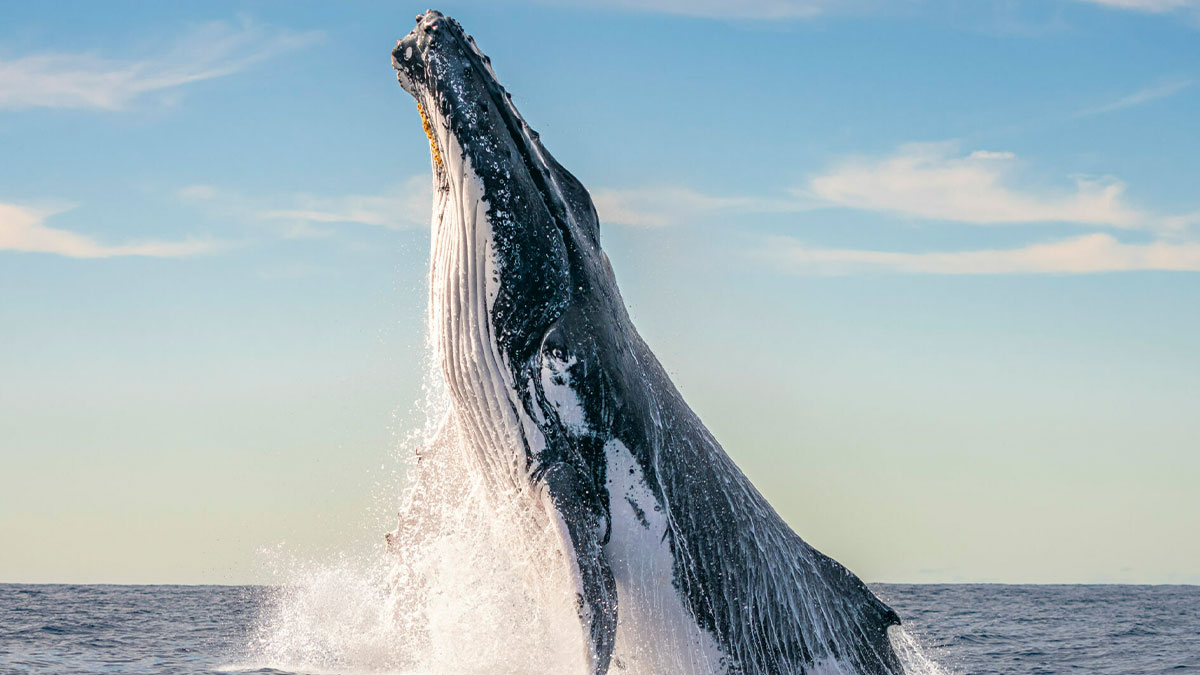

 Dark Mode
Dark Mode  No fees, cancel anytime
No fees, cancel anytime 




